 By Lynn Crosby and Blair Smith By Lynn Crosby and Blair Smith
December 5th, 2019
BURLINGTON, ON
Good morning Chair, Councillors, Your Worship.
I am Lynn Crosby and with me is my colleague, Blair Smith, and we represent the advocacy group, WeLoveBurlington. WLB fought against the prospects of municipal amalgamation in order to preserve and protect local voice. We are here today because we continue to advocate for local voice. We believe that Council and the citizens in Burlington are at a crucial point where we have one last chance to fight for the vision of Burlington that citizens have been expressing for years. We have one final opportunity to protect our downtown, preserve our waterfront and ensure that the people are heard.
 Lynn Crosby in conversation with a citizen. While we applaud the committed efforts of Planning staff, we would like to add our opinion to that of many of the citizens of Burlington and express both disappointment and concern with the two options or “concepts” that are being offered for the development of the downtown core. We will leave discussion of our main issues for whenever Council will be endorsing amendments to the Adopted Official Plan. We have many technical and policy arguments which justify a more popularly supported vision for the downtown – we will offer them then. This morning, we would like to speak to fundamental flaws in the concepts.
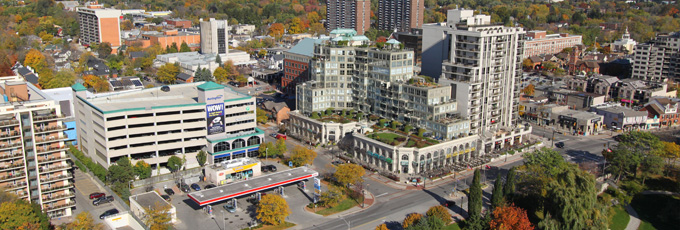 Where will the growth go? The Esso station site is reported to have been sold. WLB members attended two different sessions (hence received two different perspectives) of the recent ‘action labs’ designed to garner public opinion on what the vision and conceptual layout should be for the development of Burlington’s downtown. We also received feedback from several of our associates who attended different sessions. Notably, all sessions had the same deficiencies.
The two concepts (and the mention of a possible third melded concept) were presented – each based on the existence of the same factors or planning constraints:
The urban growth centre designation for downtown
The mobility hub located at the current bus station, and
The major transit station area designation
No consideration was given to any concept that was not based on and framed by these constraints. So, if these constraints change, and we believe that they should, then don’t the concepts also need to change? Indeed, if after the ICBL expires, and Burlington is successful in removing the classification of the urban growth centre or moving its location further north, then the limiting factors underlying the two concepts become irrelevant. Our fear is that if either of the options are selected for the downtown or anything substantially similar, then the relocation of the Urban Growth Centre becomes moot. You will be backing yourself unnecessarily into a corner that is inconsistent with your stated direction and intent.
Both concepts presented this morning are based on the Adopted Official Plan. The Adopted Official Plan reflects the direction and desire of the past Council. So, first we ask “what does this Council want?” Is the Adopted Official Plan your vision as well? The vision of the past Council, which we believe largely ignored what the people wanted for the downtown, should not automatically be inherited or repeated by you. To be fair, many of the errors made with regard to the future of Burlington’s downtown cannot be completely laid at the feet of the immediate past Council – they go further back. However, what does stand before you is the opportunity to correct these mistakes. This will be your lasting legacy.
In the ‘Action Labs,’ participants were told that the two concepts were developed because they were “defensible”. In other words, they would be consistent with the Provincial Policy Statement and satisfy the requirements of Halton Region as sole approval authority of the plan. But both concepts represent just slightly different flavours of the same thing – tall buildings in the downtown. Should there not be at least one true alternative? Participants were told that any concept that involved ‘no more tall buildings’ was not “defensible” and could not be included. So, when choosing a concept, participants selected the one that was the least offensive of the two rather than that which might actually reflect what they wanted to see.
Many participants that we questioned felt that neither concept was what was desired for downtown. Many felt that they were voting for the option that was ‘the best of a bad lot’; that even the informing vision for downtown (Section 3.3 of the Report) missed the fact, frequently expressed, that it cannot be achieved if tall buildings are part of the environment. This feeling of dissatisfaction with both process and available options is also apparent on the City’s facebook page where over 160 negative comments are registered. Overall, we believe this means any results from the polls and selections made by attendees are skewed and have little if any validity.
Perhaps the most fundamental question concerns the starting point of this process – the Adopted Official Plan. Why was this chosen when it clearly has neither legal status nor resonance with the citizens. Many who participated in the workshops had expected that this exercise was building a fresh view rather than one that merely “refines” an existing and frankly unpopular vision. Indeed, Section 3.4 of the report states that “the overall vision for the downtown remains the same”. Why? Add to this the fact that an Official Plan is intended to be read as a whole. The parts are interconnected and must be considered together to avoid taking things out of context. The downtown, which we are examining here and through this whole exercise, may be the most controversial portion of the OP but it is not the only one and each impacts the other.
WLB believes that the people need to be heard; that ‘tall building’ development in Burlington should not occur in the downtown core and particularly not in proximity to the waterfront. We will expand on this position whenever the final concept is brought back. However, we would like to be clear. WLB is not opposed to development in the interests of intensification but believes that this form of development should occur in areas other than the downtown core; if in the downtown at all, then much further north. The waterfront and our downtown are vitally important to our city and must be protected. The OP is the best way to protect them.
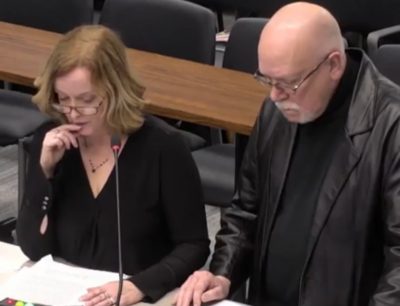 Why, wondered Crosby and Smith, was the city using the Adopted Official Plan when it did not supposedly represent the current city council? WLB believes that Council should carefully listen to the voice of the people and defend it to the best of their ability. We believe that the new OP should be redrafted to present a ‘no more tall building’ concept for Burlington’s downtown core. Indeed, what is the rush? Why are we here now? There is no deadline in the Provincial Planning Act that is forcing us to push this through without sober second thought. We have been given a “time-out” to carefully reconsider what Burlington needs and what the people want. Why are we here today at the beginning of the Christmas season, rushing to execute on a consultant’s vision for our downtown with arbitrary deadlines and time-frames for response?
We read Mayor Meed Ward’s article piece published last week in Inside Halton about the recommended changes to the OP for the downtown. We were encouraged that she feels “they still represent over-development” and that she’s “looking for an option that is more in line with what residents have expressed throughout the OP process that began in 2017.” We note that Councillor Kearns appears to have similar concerns and are equally encouraged by statements in her recent Newsletter. We also agree that the Urban Growth Centre and Major Transit Station Area designations are a concern and should officially be removed or relocated.
This whole process to date – the Action labs, the downtown tours, the surveys, the one-on-one discussions with staff and council members – is rather meaningless since it was all predicated on a direction that we believe is flawed; the premise that the popular desire for no more tall buildings at all downtown isn’t defensible and thus can’t even be considered. And why? Because we have designed these options based on the current existence of the Urban Growth Centre and Major Transit Station Area being downtown, in fact they are “givens”. A circular argument at best.
And we should neither fear nor anticipate LPAT. We believe that at LPAT the position of a municipal Council is paramount. The hearing must first understand the position of Council and the relationship between this position and the existing OP and the PPS. The type of LPAT hearing to be held and the decision resulting can be totally based on Council’s stance and direction. The new or reintroduced issue is the ‘de novo’ hearing and we will get into detail on that when we delegate next. But the critical thing is the strength of Council’s voice and the consistency of its position. A good municipal lawyer will use this to maximum advantage. This position of fearless champion of what is best for Burlington is what we expect our Council to adopt.
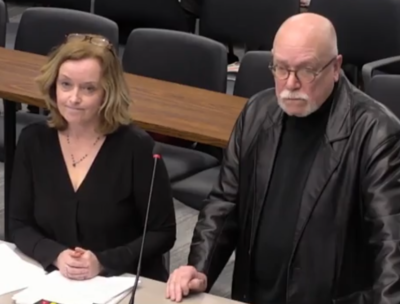 Lynn Crosby and Blair Smith during their delegation: Were they heard? Finally, the result is that we feel that we are again not being sincerely engaged or truly heard. All the public engagement that has been done has landed us here in a position where the two concepts presented do not reflect what the public wants. We understand that Council will work with staff on modifications to produce an option for endorsement by early next year. This is far too important to be done in haste.
We respectfully request that Council take as long as is needed to produce the right solution for Burlington; one that protects the waterfront for generations to come and preserves a downtown free of any additional tall buildings. Please extend the ICBL if need be, complete the necessary studies, including the transportation study, the market analysis and the fiscal impact study, among others, acknowledge that the Official Plan is an integration of perspectives and should be addressed as a single entity. There is only one waterfront and one downtown – once gone there will be no bringing anything back and, fairly or not, you as a Council will be judged by the Burlington you saved or permitted to be lost.

 By Ray Rivers By Ray Rivers
December 4th, 2019
BURLINGTON, ON
Parliament and the Government of Canada are committed to the principle of making equalization payments to ensure that provincial governments have sufficient revenues to provide reasonably comparable levels of public services and reasonably comparable levels of taxation. (Constitution Act of 1982)
The communique read ‘Premiers United” but it was hardly a love-in when the provincial leaders of this great country got together at the invitation of Ontario premier Ford this week. Mr. Ford apparently had an epiphany as he watched the federal Tory leader, Mr. Scheer, fall on his own dagger. It is a different dagger than the one Mr. Ford’s provincial predecessor fell on. But there is an inscription carved in a snow bank at the back of Brampton’s city hall – Et tu Brute?
Indeed, given the circumstances of Mr. Ford’s meteoric rise to leader of the Ontario Conservatives, there may soon be an opportunity for the job he really covets.
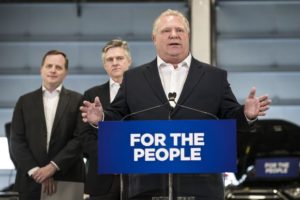 Which people: Ontario or the whole country? So no longer the national disrupter, that role having been usurped by messers Kenney, Moe and Pallister, Ford has donned a new persona. He now fancies himself the national bridge builder, not literally of course. Even Ford gets that being nasty and confrontational, the way Mr. Scheer was during the last campaign, is a proven recipe for failure. So today it’s ‘Mr. Nice Guy’ and tomorrow it’s the yellow brick road to leadership of the federal Tories.
It may not be just personal ambition. After all, national conciliator is a role which Ontario has played since confederation, most recently with Robarts, Davis and Peterson, leading the we’re-all-in-this-together charge. And Trudeau, having lost most of his battalion of liberally-minded provincial leaders since his 2015 election triumph, is hardly in a position to refuse Ford’s help.
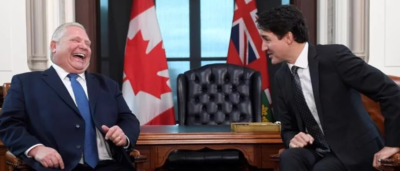 This is what “Kiss and Make up” looks like. So his kiss and make-up encounter with Mr. Trudeau under his belt, Ford clearly is out to charm the other provincial and territorial leaders, to get them to put aside the differences among them and to help him unify the nation. And nothing can unify a gaggle of subnational leaders more than a chance to pile on with grievances about the federal government. That is providing they can avoid the other big issues which might pit one premier against another.
So there was nothing in the communique about Quebec’s controversial secularism Bill 21, which had provoked a war of words… and more… between Quebec and the high and mighty Manitoba premier, who somehow thinks it is his business to intervene in an internal Quebec provincial matter.
Nor was there any mention of Alberta and Saskatchewan potentially ramming pipelines full of diluted bitumen through Quebec and B.C. to the coasts to pacify Alberta, there were a few statements about resource development with some less than subtle references to Canada’s environment assessment law. And despite Quebec Premier Legault’s objection to the increased production of what he calls ‘dirty oil’, he would sign onto anything that limited and constrained federal powers.
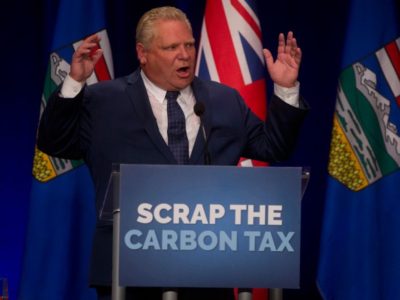 Ontario Premier Doug Ford There was no mention of the carbon tax, despite four provinces taking the federal government to various courts, including the Supreme Court, over that policy. And neither was there anything but a passing comment around climate change, the most important national issue which faced voters in the last federal election. It appears nobody wanted to provoke a stand off between the climate deniers and delayers and the other folks who actually understand the issue.
And although Albertans have been recently venting about the unfairness of Canada’s federal-provincial equalization program, there is no inkling that the premiers even discussed it. They did spend some quality time trying to fine tune the Fiscal Stabilization Program, an equally complicated multi-year mechanism intended to help provinces through rough economic patches. And as one would expect from kids in a candy store their fix was to simply demand more. Like equalization, this is federal money – somebody else is paying, right?
Equalization is one of the glues that keeps this nation together. It’s been a fundamental part of Canada since confederation though it was only formalized in 1957. And while Pierre Trudeau may have held the pen as it was being written into Canada’s 1982 constitution, equalization was initiated, formalized and most recently amended all by Conservative governments. And those last amendments which, in fact, expanded the benefits of the program to Quebecers were penned by Stephen Harper, with Jason Kenney at the Cabinet table,.
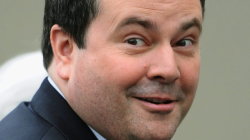 Jason Kenney So for Jason Kenney now to be talking of seriously downgrading or even ending equalization is two-faced hypocrisy. Of course we know it was a baseless threat to Quebec over a pipeline which will never be built. But it was also politics – what better way to fire up Albertan voters, using exactly the same kind of tactic Quebec separatists have employed for decades.
Alberta is by far the wealthiest province with the greatest fiscal capacity in the country and also the one with the lowest taxes. Per capita income is 30 to 40% greater than the Canadian average. And that has hardly changed even after the oil patch experienced its big price shock a couple of years ago.
And as for Quebec, the lion’s share of the equalization budget does go that province, but given its population Quebecers receive the smallest share per capita among all the have-not provinces. Albertans may look at Quebec with some envy though. After all, it has balanced its budget. That has to do with its fiscal management and its degree of taxation, almost twice as much as Albertans pay. And unlike Alberta, the province also manages both a child care and pharmacare program.
Quebec’s pharmacare program, implemented in 1997, is a two-tiered system, similar to Ontario’s OHIP+ (youth pharmacare) – except it applies to all ages of Quebecers. It has received accolades from the Fraser institute claiming it “offers better drug coverage and quicker approval for new drugs coming to market than the rest of Canada.” In fact the plan covers twice as many pharmaceuticals as Ontario does.
But drug costs are higher and rising rapidly, particularly for the public tier of the ledger. Canada’s expert panel on pharmacare rejected the Quebec model, recommending a single payer system as a more efficient (lower cost) and sustainable option. In any case, some premiers, such as Manitoba’s Pallister, aren’t willing to even entertain the notion of a universal pharmacare program.
Pallister, much like Ontario’s Ford, has an intractable problem with hallway medicine in his province’s hospital wards. And like Ford, his prescription is turbulent restructuring, cost-cutting and eliminating health care jobs. So Pallister, like Ford is looking for more federal money to get him out of the pickle jar in which he has placed himself. That is a negotiating tactic – he’ll not agree to pharmacare unless it comes with a Santa-sled of new cash.
 NDP leader Jagmeet Singh Quebec, and possibly Alberta, can be expected to opt out of any national pharmacare program, regardless that the alternative would be more costly. So getting to a universal pharmacare program across the country may be as much of a pipe dream as Mr. Kenney piping his province’s diluted bitumen across la belle province. Still pharmacare was at least given honourable mention in the final meeting communique. And it is the gun which Mr. Singh is holding to the prime minister’s head.
The next step in Mr. Ford’s unifying process involves the premiers meeting with Mr. Trudeau. But nobody should hold their breath waiting for any kind of unity coming out of that meeting either. If you do you might end up in one of Mr. Pallister’s hospital hallways.
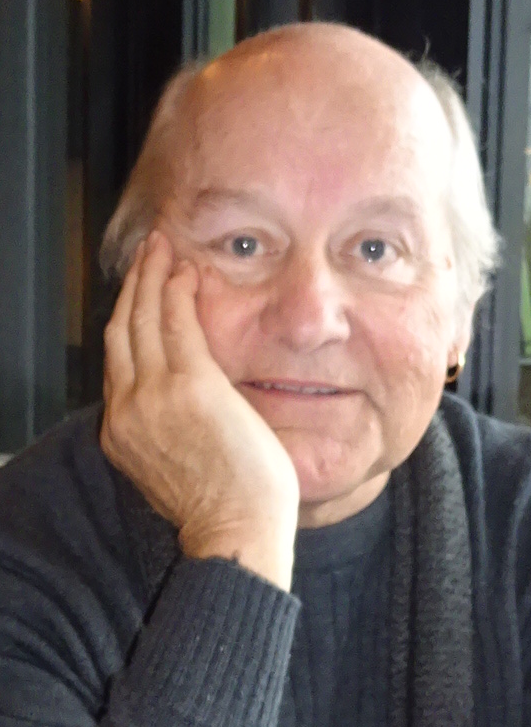 Ray Rivers writes regularly on both federal and provincial politics, applying his more than 25 years as a federal bureaucrat to his thinking. Rivers was once a candidate for provincial office in Burlington. He was the founder of the Burlington citizen committee on sustainability at a time when climate warming was a hotly debated subject. Ray has a post graduate degree in economics that he earned at the University of Ottawa. Tweet @rayzrivers Ray Rivers writes regularly on both federal and provincial politics, applying his more than 25 years as a federal bureaucrat to his thinking. Rivers was once a candidate for provincial office in Burlington. He was the founder of the Burlington citizen committee on sustainability at a time when climate warming was a hotly debated subject. Ray has a post graduate degree in economics that he earned at the University of Ottawa. Tweet @rayzrivers
Background links:
Premiers’ Meeting – Fiscal Stabilization – Alberta Economic Stats –
More Economics – Equalization – Kenney Equalization – Quebec Drug Plan –

 By Pepper Parr By Pepper Parr
December 3rd, 2019
BURLINGTON, ON
It was a year ago this evening – the new city council was sworn in.
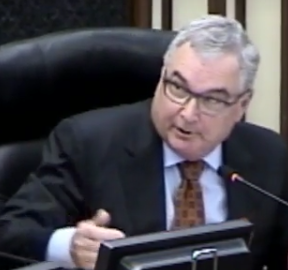 City Manager James Ridge is shown the exit door. The next day the Mayor called a Special Meeting of Council and got their approval to fire the city manager.
There were other changes in the wind. The Council’s first budget increase was modest – but the Mayor had to convince her Council to shake $4million out of the hydro Reserve Fund.
That this was going to be a different council was made evident the night the Goldring Council held its last meeting. Meed Ward had some comments she wanted to make – Mayor Goldring politely advised her that comments were not permitted at that point. Marianne Meed Ward stunned the Mayor and the City Clerk that she wanted to speak on a point of personal privilege. While the Clerk was shuffling through the Procedural bylaw Meed Ward gave her a copy with the appropriate section marked.
And then she let blast. The full report of that meeting is linked below.
Paul Sharman was the only holdover from the 2006 through to 2018 terms; the others either resigned or were defeated. ( In 2010 every council member was re-elected.)
The other five were new to municipal politics. They had basically zero political experience and several had to struggle but they learned the ropes and little by little we began to see where there was some talent and where some help was going to be needed.
There was a new city manager who had served the city in the past; he was known, well-liked by most and was able to bring some stability to an administration that had gone through a very difficult period of time and knew that there were many rough months ahead.
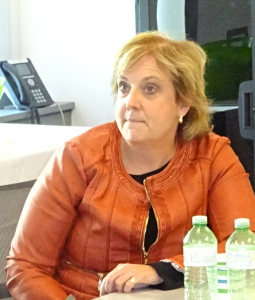 Mary Lou Tanner’s job disappears – she finds the exit door. The Deputy City Manager was shown the door; there was a new Chief Planner with a team that needed help and support.
The learning curve for the five new council members was steep; some are not doing all that well. Some have surprised us while others have been a disappointment.
What is evident is that this Council is pulling together and doing so rather well.
Collectively they are taking on huge issues – Climate Change was a challenge they did not shirk.
The opportunities to do things that were badly needed were embraced and while there is a lot that is not yet known – the outcome, whatever it is, will not be because this council didn’t try.
The members of council are learning the strengths and weaknesses of their colleagues; they are as well learning which Staff members are straight shooters and which are not to be relied upon all that much.
None of the five had any idea that the experience they are having is what they imagined the day they submitted their nomination papers.
The city’s downtown core is under an Interim Control Bylaw which means nothing moves forward until the research and the deep thinking is done.
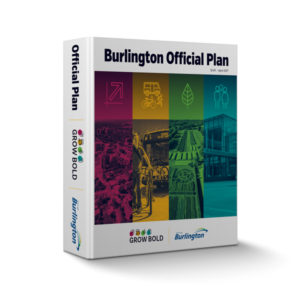 Official Plan gets re-write. 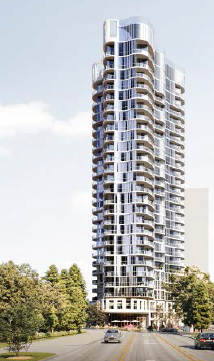 Might work in Mississauga – not wanted in Burlington. The re-write of portion of the Official Plan is taking place – with the Planning staff trying every idea out there to involve the citizens.
Some stunning developments have been brought forward; all of which would be embraced quickly by Mississauga – but Burlington is not Mississauga.
Council has to come to terms with wanting to do everything and what fiscal reality will permit. There are only so many Reserve funds that can be raided.
At this point council deserves to be told publicly that we appreciate what they are trying to do and wish them well as they enter their second year of their four year term.
A closer review however is merited.
The day Meed Ward let the outgoing council have it right between the eyes.
Salt with Pepper is the musings, reflections and opinions of the publisher of the Burlington Gazette, an online newspaper that was formed in 2010 and is a member of the National Newsmedia Council.

 By Ray Rivers By Ray Rivers
November 30th, 2019
BURLINGTON, ON
Today it’s just a small group of young folks, one only 12 years old, taking the provincial government to court under Section 7 of the Canadian Charter of Rights and Freedoms, which promises protection for life, liberty and security of the person. Yet, according to the science, they more than the 55 year old Mr. Ford, will suffer “widespread illness and death” because of the policies of this provincial government.
 Doug Ford: cancelled virtually all of the positive environmental policies of the previous government, as if the environment is a partisan issue. Even the federal government, which had pioneered a number of progressive climate measures, including the carbon tax, is being sued (by another group of young Canadians) for not doing enough. But Mr. Ford’s government is clearly culpable – having actually cancelled virtually all of the positive environmental policies of the previous government, as if the environment is a partisan issue and he needed to show he was different. So it’s as if Mr. Ford deliberately provoked this kind of reaction, the first such legal action against a provincial government.
Ford slashed the province’s carbon emissions reduction targets. He is suing the federal government at the Supreme Court over a carbon tax, imposed only after he cancelled the province’s own cap-and-trade carbon pricing program – the most cost effective way to reduce all of the peoples’ carbon footprints.
While taking credit for the results of the provincial innovative green energy program, which reduced Ontario’s climate damaging emissions by 22%, Ford has bragged about having shut down the program. Coal which was used to produce 25% of the province’s electricity in 2003 was phased out by 2015 and largely replaced by conservation, wind and solar power.
 Some see the wind turbines as a pleasant addition to a skyline But Mr. Ford doesn’t like the sight of wind generators, so he has killed some 800 renewable energy projects undergoing completion. It is costing a quarter billion dollars to cancel these investments. This action winds down the development of renewable energy in Ontario and with it the thousands of jobs already in the wind and solar industry. Canadian Solar, for example, used to be the third largest global solar manufacturer.
Mr. Ford has also declared war on electric vehicles, and reduced the pump price of gasoline, thus encouraging greater gasoline consumption. He ended the provincial electric vehicle (EV) incentive program and killed the program of installing EV charging stations across the province.
Mr. Ford says he believes in climate change and has a plan to deal with it, but that is clearly rubbish. Just ask those young people suing him or all the people in this province who voted federally for political parties supporting the carbon tax.
And this goes beyond climate change. In 2005 Ontario issued 15 smog advisories covering 53 days, due in large part to pollution from Ontario’s coal-fired electricity. An independent study estimated the health, financial and environmental costs of that pollution at $4.4 billion a year. More recent studies have shown that exposure to nanoparticles emitted in automobile and truck exhaust fumes can also lead to a number of health effects including a rising number of cases of brain cancer.
 This is not the way to determine who governs us. Litigation is today’s new democracy. As we’ve previously discussed in this column, the inadequacies of our first-past-the-post electoral system cry out for electoral reform. In the absence of that reform we have to rely on the courts to ensure politicians listen to the people between elections. So we should expect more legal action – individuals suing government and governments in turn suing industry to recover the costs of the health care and environmental damage and costs they cause.
Current emphasis on environmental litigation has been likened to what has happened with the tobacco industry. Those damage law suits were less about the fact that cigarettes are addictive and cause cancer and heart disease, but that the companies knew all of this and misled or withheld it from the public and public health authorities.
There is substantial evidence that oil company researchers and executives understood that the ongoing expansion of petroleum consumption would lead to irreversible global warming. Not only did they fail to inform the public but deliberately misled all of us. And isn’t the imperilment of the planet’s climate a crime for which no punishment is too harsh.
 Another voice, Canada’s Ecofiscal Commission, recently concurred with other experts that its analysis demonstrates that carbon pricing is the most cost-effective way for the country to hit its 2030 Paris emission targets. Of course they argue that the price would need to rise to $210 per tonne compared to $30 today. And then former Ontario Liberal environment minister Glenn Murray, who introduced Ontario’s cap and trade carbon pricing program, now believes that it is too late, even for a carbon tax to be effective. Another voice, Canada’s Ecofiscal Commission, recently concurred with other experts that its analysis demonstrates that carbon pricing is the most cost-effective way for the country to hit its 2030 Paris emission targets. Of course they argue that the price would need to rise to $210 per tonne compared to $30 today. And then former Ontario Liberal environment minister Glenn Murray, who introduced Ontario’s cap and trade carbon pricing program, now believes that it is too late, even for a carbon tax to be effective.
 Ray Rivers writes regularly on both federal and provincial politics, applying his more than 25 years as a federal bureaucrat to his thinking. Rivers was once a candidate for provincial office in Burlington. He was the founder of the Burlington citizen committee on sustainability at a time when climate warming was a hotly debated subject. Ray has a post graduate degree in economics that he earned at the University of Ottawa. Tweet @rayzrivers Ray Rivers writes regularly on both federal and provincial politics, applying his more than 25 years as a federal bureaucrat to his thinking. Rivers was once a candidate for provincial office in Burlington. He was the founder of the Burlington citizen committee on sustainability at a time when climate warming was a hotly debated subject. Ray has a post graduate degree in economics that he earned at the University of Ottawa. Tweet @rayzrivers
Background links:
Youth Legal Challenge – Ontario Coal – Wind energy –
Air Pollution – More Air Pollution – Canadian Solar –
Car Culture – Oil Legal Cases – More Oil Legal –
Carbon Tax Too Late –

 By Pepper Parr By Pepper Parr
November 25th, 2019
BURLINGTON, ON
Recall those occasions when you put two and two together and realize that the total is five?
 This crew will probably not be clearing the leaves from your property. They were working along New Street when this picture was taken. Keep that in mind as you look through what we have written about the Loose Leaf Collection Program and read the comments carefully.
Could it be that City Council is giving serious thought to the idea of killing the program as part of a tax saving measure?
The program is expensive and no matter that the city does – something goes wrong.
 Why not just get rid of it early in their term of office; give the native’s time to get used to the idea and boast about how you have managed to keep the budget at just a pinch above the 4% increase last year. Why not just get rid of it early in their term of office; give the native’s time to get used to the idea and boast about how you have managed to keep the budget at just a pinch above the 4% increase last year.
If that doesn’t fly – how about a Loose Leaf Collection levy?
This is a story that still has some legs – let’s see where the tail that wags the dog takes us?
Salt with Pepper is the musings, reflections and opinions of the publisher of the Burlington Gazette, an online newspaper that was formed in 2010 and is a member of the National Newsmedia Council.

 By Ray Rivers By Ray Rivers
November 22nd, 2019
BURLINGTON, ON
If you are a political follower like me, you would have been glued to the TV watching the US House of Representatives impeachment hearings for the last two weeks. It is the best entertainment on the tube – better than the latest season of the Crown. And the Democrats have been brilliant, unfolding their story so there can be no doubt about Trump’s guilt in his latest attempt at corruption.
Call it quid pro quo, bribery, international blackmail, breach of trust, abuse of power – take your pick or tick all the boxes. It’s corruption – dishonest or fraudulent conduct by those in power, typically involving bribery. And Trump will almost certainly be impeached by the House of Representatives, though politics being what it is south of the border, he is unlikely to be removed from office.
Corruption seems to be contagious these days. Trump’s closest ally, Israeli PM Netanyahu, has also been indicted for corruption. But at least he didn’t betray his nation’s security as Trump has been doing since his election, given all the irrefutable testimony of the last two weeks.
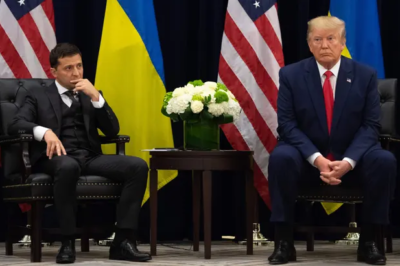 Donald Trump with Ukrainian president Volodymyr Zelenskiy. Trump has been accused of withholding military aide until Zelensky opened an investigation into Joe Biden who wants to run against Trump in the 2020. Few countries can hold a candle to the former Soviet republics when it comes to corruption, and Russia and Ukraine in particular. So Trump figured – what’s a little more corruption – they must be used to it? Or maybe he was just trying to please his master in Moscow.
Canada has had its own share of corruption. Stevie Cameron’s best seller, ‘On the Take’, gives an uncontested accounting of the slime we’d seen over the Mulroney years. And don’t forget the former PM accused of accepting brown paper bags full of cash from that Karl Heinz character. Of course there was the Sponsorship scandal which ultimately kept the Liberals out of power for almost a decade and at one point relegated them to third party status.
Andrew Scheer thought he had hit pay dirt, letting rip accusations of corruption and criminality at Mr. Trudeau over the SNC prosecution. But it turns out there was no smoking gun, just a lot of smoke. Mr. Trudeau had been cited by the Ethics Commissioner a couple of times and he has apologized at least once. But then even mild mannered Stephen Harper ran up a sizeable laundry list of potentially impeachable offences.
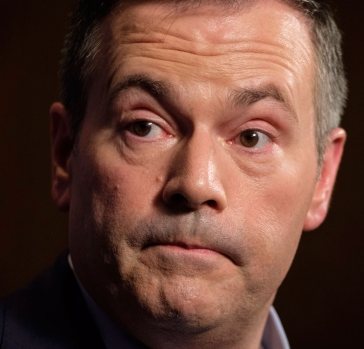 Jason Kenney fired the province’s elections commissioner who was investigating just how Kenny got elected. The latest unwinding of Canadian corruption takes us to Alberta and Jason Kenney. When the province’s elections commissioner investigated some of Kenney’s dirty tricks getting to office, and charged him with over $200,000 in fines, Kenney just borrowed a page from the Donald Trump’s playbook and fired him. And when opposition leader Notley objected, the speaker kicked her out of the legislation and the majority Conservatives just let Kenney off the hook.
Doug Ford had brazenly attacked the Kathleen Wynne government as corrupt. But he must have known that was pure fiction. Indeed the Liberals had an imperfect record during their decade and a half in power, and especially regarding McGuinty’s gas plant mess. But there was no corruption. Even the former premier’s budget numbers were proven to be accurate, at least in light of the auditor general’s observations.
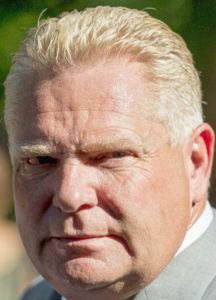 Are the people who voted for Doug Ford experiencing buyers’ remorse? Ford’s popularity has tumbled in Ontario – it’s called buyers’ remorse. Anyone expecting the PC’s to better manage the treasury can’t be happy that the deficit is now climbing to over $2 billion more than it would have under the Liberals this year, despite Ford’s best efforts to slash and burn public services. And that slash and burn will end up in a war in the not too distant future as teachers and other public service employees confront ignorance and a lack of respect from this hostile government.
Ford has been boasting about his other war, the one on the environment. He is proud of how it only cost taxpayers an additional $200 million dollars to cancel and roll back some 800 renewable energy projects. But didn’t Ontario voters support climate action in the last federal election. His actions mean that our growing electricity demand will now have to be supplied with climate damaging natural gas.
And speaking of climate change, tax payers are on the hook for as much as $2 billion dollars a year since Ford cancelled Ontario’s cap and trade carbon pricing system. And we’re also paying for his $30 (plus) million ideological court battle with the feds over the carbon tax – which everyone knows he will lose.
There is no better example of the Ontario government’s abuse of power than forcing every gas station in the province to stick a political message on their pumps. Fortunately the labels seem to want to fall off. Having managed his family’s label making company, one would think that labels would be the one thing Ford could get right.
The Ford government has even messed up the cannabis file having wasted over $40 million dollars this year and failing to get an effective private distribution system in place. The Liberals had planned to use the experienced and profitable LCBO by contrast. Instead something like 80% of the province’s cannabis is still delivered through the blackmarket today.
Given the Ford family’s history around Ontario’s drug culture, one would think that pot would be the other thing he’d be able to manage without screwing up. One can only speculate into whose pockets some of that $40 million went.
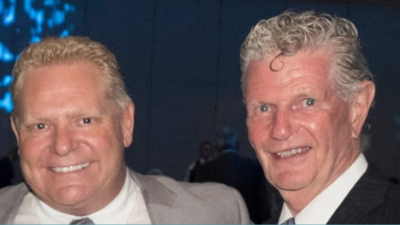 Doug Ford poses for a picture with Ron Taverner, his first nominee for Chief of Ontario Provincial Police. We all live in glass houses when it comes to calling out corruption and it wasn’t long before the cracks started appearing in Ford’s. So far it’s only been a little bit of patronage, nepotism and cronyism. But he has still got two and a half years to go.
Particularly troubling is his government’s intention to muck with judicial appointments. As we’ve learned from the US impeachment hearing, that is perhaps the number one source of Ukraine’s corruption. Can we really trust this government to avoid that pitfall? Can we really trust this government?
Background links:
Israeli Corruption – Mulroney – Harper –
Alberta – Ontario Budget – Ford Cronyism –
Ford Cannabis – Black Market Pot – Politicizing the Judiciary –

 By Tom Muir By Tom Muir
November 15th, 2019
BURLINGTON, ON
At a November 4 meeting of Committee of the Whole, transportation staff was giving Council Committee an overview of their five year business plan for Transit.
Councilor Sharman had read the report carefully and he had major problems with some of the numbers. He didn’t like the math, and he had some very challenging words to staff on what he thought.
Subsequently, he made a motion to forward the staff report to the Council meeting Agenda of Monday, November 18 for further scrutiny and discussion. This motion was carried 5-2.
 The disputed Table 5 It will be interesting to see what happens at this meeting and how Council responds to his concerns and position. This analysis and startling assessment of a staff report, by a Councilor, is very unusual in my experience and is what motivated me to write this opinion piece.
“The numbers are all completely wrong, and there are a number of things where they don’t make sense”; “Table 5 is completely wrong”; are the gist of what he was reported to say in a story by the Burlington Gazette.
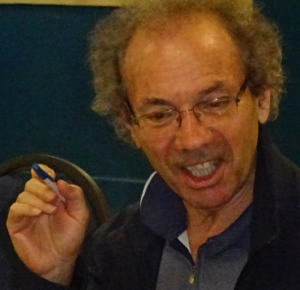 Tom Muir – if there is a flaw in your data – he will find it. Since I was a citizen member of the City Development Charges Consultation Committee that considered the transportation and transit service plans, and I had expressed serious concerns of my own to this Committee on the transit plans and unfunded costs to 2031, and Councilor Sharman was the Committee Chair, I reached out to him to ask what was behind his serious concerns and the words he chose.
I found we had a lot in common in our views of what is really a complicated situation that is a big deal in its own right, but in particular, for laterals to the City Budget, which happens to be under review right now.
Significantly, the stated focus on Table 5 of the 5 year business plan report goes to the heart of his discontent as the Table summarizes the finances of the 5 year business plan – Planned Operating Costs and Revenue, wherein you can see the bottom line Net Operating Costs, dollars that need to be mostly funded from somewhere in the Budget, going from about $13.5 million to almost $20 million annually from 2020 to 2024.
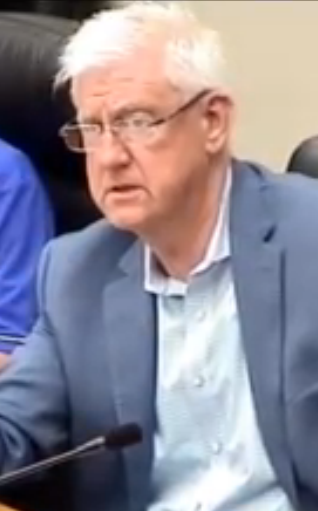 Councillor Paul Sharman And peering a little closer into some line items you can see another possible alarm bell in the fact that the Operating Costs are comparatively “hard”, if implemented, but the Revenue estimates, which are based on the assumed ridership associated with the services provided by the costs, are decidedly “soft”, and to the both of us, not believable.
As far as I can discern, neither Mr. Sharman nor I have any idea where this growth is going to come from, and this was also discussed at the DC Committee meetings. This is also being pushed by the Halton Region in their DC study to increase the modal split by assuming it can be done.
In our discussion I think the crux of the matter is shared – the lack of a rationale to show how the transit system configuration proposed will work to provide real results. Remember, this is a Business Plan, and it seems obvious that such a thing should have a firm evidentiary foundation in support of an expectation that it will work.
Mr. Sharman put it this way; I summarize
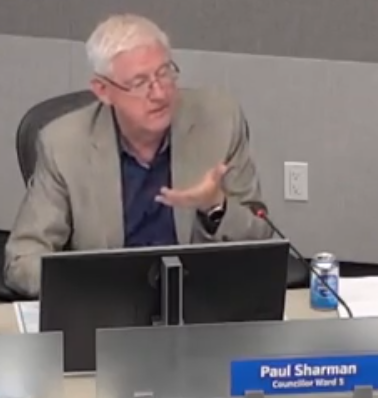 Councillor Paul Sharman explaining what was wrong with some of the data in a transit report. 1. There was no assessment of the Burlington market, economic factors, routes (maybe 80% of ridership is all routes 1 and 101), long term history of transit numbers, forecast City demographic change and ridership mix impact.
2. Burlington ridership and routes are not much different than they were 20 years ago i.e. primarily between Burlington and Hamilton south of the QEW. The report has no analysis of ridership split between handivan and regular buses routes. Presumably, since we have been adding handivan buses and drivers, and with the increasing elder population % ridership growth the projected growth would be worth knowing.
3. The numbers in the report are entirely unrepresentative of anything to do with Burlington. The report is entirely premised on Region of Halton Modal Split targets for the next 5 years and from there calculating what ridership numbers would have to be in order to meet the 5 year target, which is 23% average growth per year.
4. The consultant then used Canadian Urban Transit Association standards to determine what that meant in terms of how many more buses, drivers, maintenance staff, overhead staff and facilities would need to be added to the budget in each year going forward. CUTA standards are aspirational goals that have been demonstrated to not actually represent any Burlington peer municipality (Jeff Casell, Waterloo University 2012). They are more representative of highly intensified big city circumstances.
5. So when you look at the numbers in the table provided, it shows that the 23% average will be highly front end loaded with a 36.5% growth in year 1 of the plan, i.e. from 2,000,000 riders in 2019 to 2,730,000 in 2020. When Mr. Sharman challenged the consultant on the number he was unable to explain the distribution.
6. The critical concern in this is not so much the report per se, but that that the 2020 budget for the City of Burlington includes funding to purchase 4 new buses and hire 8 new drivers. The report proposes that the City should do that in each of the following four years at a cost of $millions each year. Keep in mind that 1% increase in the City of Burlington budget equals $1.6m. Further, that transit revenue, presently, represents less than 25% of operating cost.
The risk is that that the City is about to pour all sorts of real hard dollars into a plan that is completely devoid of any substantive analysis, ridership projections or realistic plan.
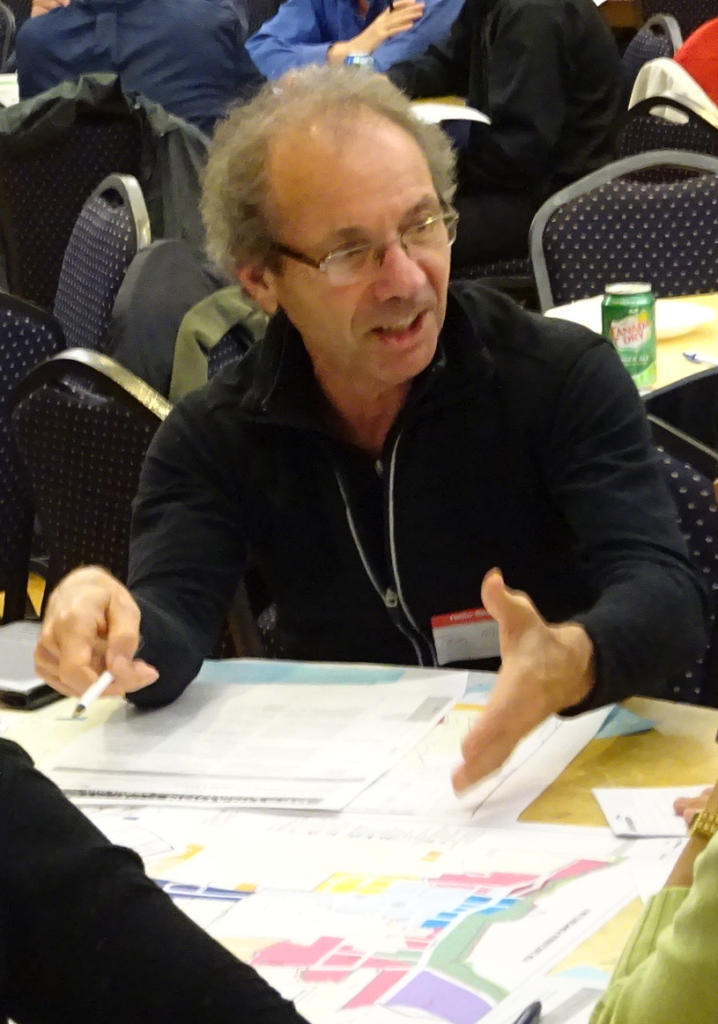 Looking for a Plan B. We want to see a Plan based on a modal split that is realistic, and will work to service the needs and wants of residents without forcing people onto buses, or blithely assuming they will walk or bike (doubling from 5 to 10%; remember winter?)), and there will be fewer cars.
Is there a Plan B, and what form does it take? What rational criteria or indicators are being used to stage or trigger additional service supply, and when do you stop or lag additions? What constitutes success?
What about “failure”? – remember the biking trial project failure (New Street Road Diet) ; and stagnant transit ridership, at a 2% modal split, that must be completely reversed and exponentially energized upward continuously by 600% by 2029-2031 or so?
For most of my needs, the bus doesn’t go there. Walk, and bike and bus all you want, but most people basically have to drive to survive in Burlington and surrounds. It’s called needs, and work, and distance, and time, and family and so on in reality.
How to get to Costco, Walmart, Longos, Fortinos, Sobeys, Clappisons Corners, Terra Landscape, Connons Garden Center, Canadian Tire, and so on.
The bus doesn’t go there. I need a case of beer, a lawnmower, lumber, groceries for a week, hockey for the kids, music lessons, all of this on Saturday, etc. etc. Try walking, biking or busing this stuff there and home.
For most commuters, except as noted for route 1 and 101, the bus doesn’t go there I believe.
I have never sensed a significant latent demand for such a transit service on the part of the majority of residents.
These are big decisions you have to make that are interrelated and not explained.
Have you done financial risk assessment for all costs? When do you stop the experiment? Do you have a fail-safe mechanism?
Remember, Burlington cannot fund transit from Development Charges (DC) – the transit plans to add services are considered to be largely “benefits to existing” residents. So there are large cost additions to be funded, and very small contributions for transit from developers as part of the ever-growing need for transportation services due to growth in Burlington and Halton Region. Also remember the provincial policy drivers that are forcing a renewed Grow Bold, at higher cost to the city.
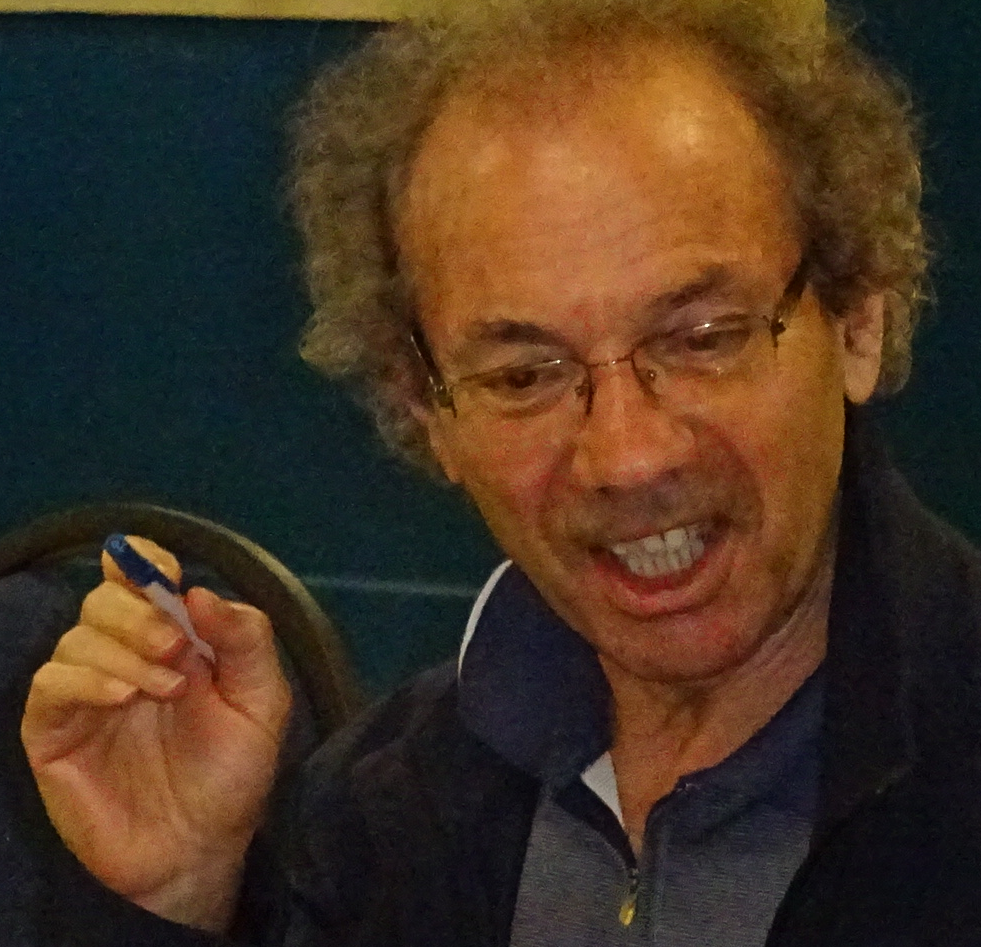 Tom Muir – uses a sharp pencil when looking at numbers. It’s time that this transit cost burden on the city, and not the development responsible, be reconsidered or the transit plans will not be sustainable and fully funded, which is what the transportation staff have said is needed and the goal.
In conclusion, If staff are going to direct the city to implement the transit and transportation quantitative plan identified, and Council agrees to approve this, with all the costs identified with no visible tracking of results, and triggering of rational incremental system steps based on results, and financial risk assessment and management controls in place, then they must be held transparent and accountable for showing how it is realistic and founded on evidence, visible trends, and realistic/rational possibilities for changing the behavior of city residents in the substantive way described.
I was told that this issues set identifies an area where we have to improve and that’s communication. I believe we’re looking for the same things and that’s a sustainable, funded transportation system that moves us (likely slowly) away from total auto dependency over the long run while keeping in mind that the auto is still the primary mode of travel.
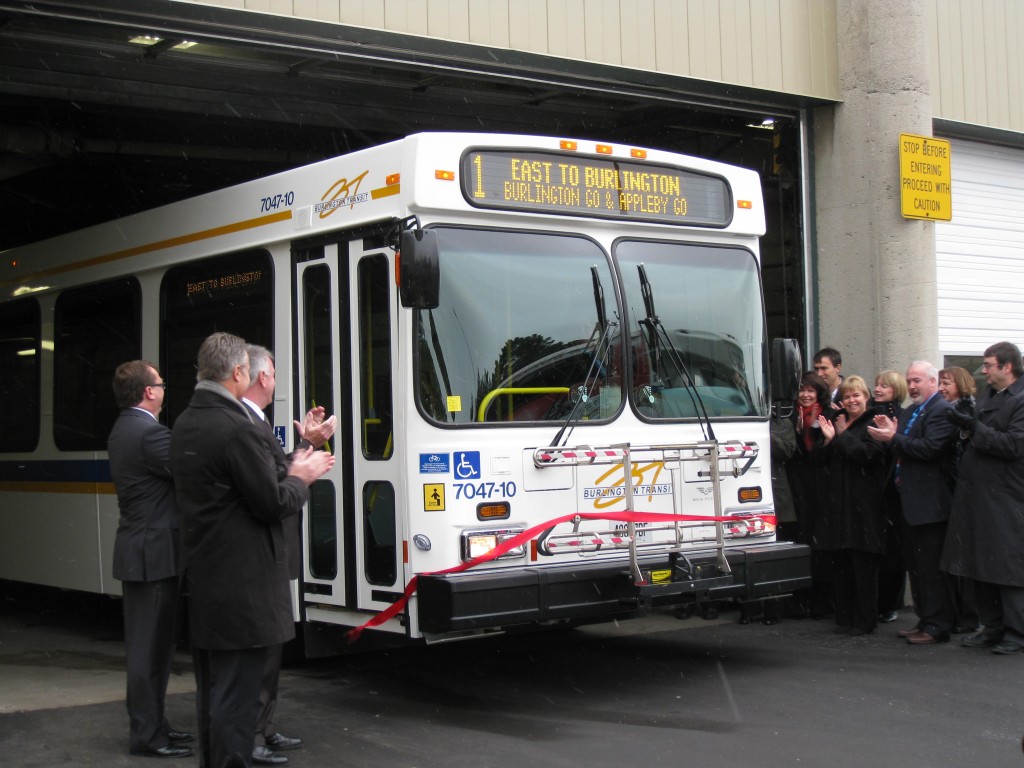 Couple of million in high priced talent welcoming a new bus into the fleet. You can buy and supply all the buses you want, but getting people to demand and use these is an entirely different matter, conceptually and practically. I don’t think it legitimate to try and force people into acceptance of a rejigging of their lives.
I see nothing presently, or moving forward from this, that shows awareness of what the actual problem is other than attributing it to people not liking it or the change. The change is not the problem. It’s the change based on impossible levels of different behaviors people are expected to manifest for no reason.
I see no fact-based explanation for why people should or could use a significant and costly increase in transit and pay the estimated large cost share, as calculated. I support some transit increase, but I see no demonstration and evidence-based reasoning to support what I see here, never mind the DC Plan to 2031.
This needs evidence, and not just rationalization, to show how the transit system configuration proposed will work to provide real results.
All I have seen so far are assumptions that people will somehow and magically change.
Finally, remember a basic principle governing any planning exercise is; “that everything that starts with a faulty premise is bound to fail”
Editor’s note: Mayor Meed Ward has said she wants transit to be free for everyone. Factor that into the Muir comment and the Sharman point of view.
Related new story:
The numbers didn’t add up.

 By Ray Rivers By Ray Rivers
November 14th, 2019
BURLINGTON, ON
“The eyes of all future generations are upon you. And if you choose to fail us I say we will never forgive you. We will not let you get away with this. Right here, right now is where we draw the line. The world is waking up. And change is coming, whether you like it or not.” (Greta Thunberg)
For a minority government to survive it will need support from one or more of the other parties – each has their own priorities.
For the NDP, Greens and BQ a top priority is for the federal government to do more about reducing Canada’s carbon footprint. And that is exactly the opposite of what the opposition Tories are looking for.
Canada’s environmental performance among G7 nations has been graded a big fat failure. Along with the USA and Japan, we would push the world’s thermometer up 4 C, almost three times the Paris agreement goal of 1.5 C.
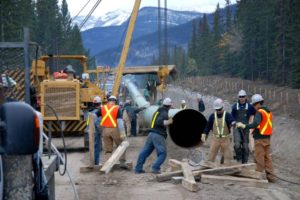 Canada is the fourth largest oil producer in the world and fourth largest oil exporter. Alberta is the largest source of Canada’s carbon emissions. And despite all the noise about how the oil industry is dying, Canada is the fourth largest oil producer in the world and fourth largest oil exporter, even without any more pipelines. In fact Canada exports even more oil than we use domestically.
 Alberta Premier Jason Kenney. And while investment in new oil development has petered-off since the oil price crash back in 2015, Alberta is still the wealthiest province in the federation with the highest per capita incomes. So when Jason Kenney says that the rest of Canada doesn’t understand the west, he means that we don’t get that he wants even more… money. He’ll tell you that Alberta’s oil contributes to our high standard of living, and he’s right though that would be less the case were he to be successful in dismantling Canada’s income equalization program.
On that note, it wasn’t even ‘Albert’s oil’ before the federal government deeded natural resources to the prairie province in the 1930’s. Not that we should expect a thank you, but recall how former premier Lougheed beat up Justin’s father when he introduced a plan to share those national resources for the benefit of the rest of the country, and wean us off foreign oil in the process. The irony clearly escapes Albertans when they demand more pipelines, because Pierre’s government would have built them all under that program.
And today, there is monumental disconnect in vision between the oil producing provinces and the rest of us Canadians. After all, two thirds of us voted for a political party whose main policy was to reduce Canada’s carbon footprint, not increase it.
 An unhealthy similarity to the southern United States. So using the ‘best defence is an offence’ argument, Mr. Kenney and Mr. Moe have declared a kind of civil war. Yes, their demand for the provincial right to unimpeded oil patch development has an unhealthy similarity to the southern US states once demanding their right to maintain slavery.
How is a prime minister supposed to govern a nation so badly divided? Mr. Scheer has counseled appeasement. Cancel the carbon tax and ram through pipelines everywhere to allow the western provinces to reinvigorate investment in the oil sector. That is exactly what he would have tried to do had he been elected.
But that will not fly with the rest of the country, especially not in Quebec or B.C. which are opposed to more pipelines and have their own carbon pricing systems in place. Mr. Moe left his meeting with Trudeau complaining that Justin wasn’t listening. But it’s not so much about listening as about the message.
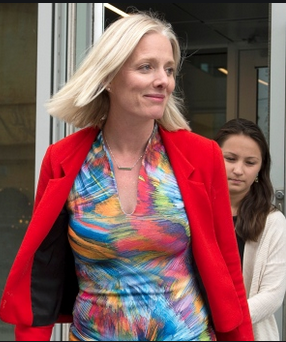 Catherine McKenna: Minister of the Environment. So when Trudeau fashions his new Cabinet he will need to make reconciling those western secessionist voters a priority. At a minimum that will require some fresh faces in the key area of national dispute, climate change. Catherine McKenna has been a great voice for the fight against climate change, leading the introduction of some 50 measures to reduce Canada’s carbon footprint, including the carbon tax.
McKenna has been passionate, and even combative, on the environment in dealing with premiers like Mr. Ford. And In return she has been ridiculed by the ultra-right media and been the victim of personal threats to herself and her family. It would be a surprise were she to stay in that portfolio when the PM announces his new cabinet next week. But second guessing the making of a Cabinet is a fool’s game – only the PM knows.
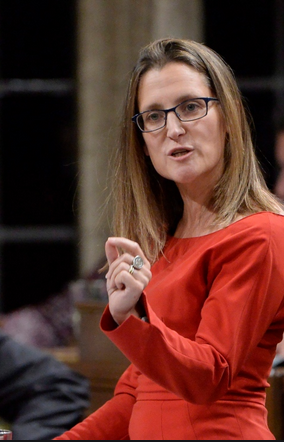 Chrystia Freeland – kept the NAFTA negotiations on the table and moving. Though there is brilliant and talented Chrystia Freeland. She’s this rock star and skilled negotiator who kept the NAFTA file together, despite an unpredictable US President Trump. An Alberta native herself, she is also a Rhodes scholar and former writer with a number of journals including the business oriented Economist. She is also widely admired by most Canadians, some even suggesting she should be our next PM.
Changing the channel in the oil patch provinces would be a challenge deserving of her skills. It is a tall order and failure is not an option. History will show that it was mainly Pierre Trudeau who kept Quebec in Canada during those early seventies. And now it’s up to his son to make sure we shore up the west.
 Ray Rivers writes regularly on both federal and provincial politics, applying his more than 25 years as a federal bureaucrat to his thinking. Rivers was once a candidate for provincial office in Burlington. He was the founder of the Burlington citizen committee on sustainability at a time when climate warming was a hotly debated subject. Ray has a post graduate degree in economics that he earned at the University of Ottawa. Tweet @rayzrivers Ray Rivers writes regularly on both federal and provincial politics, applying his more than 25 years as a federal bureaucrat to his thinking. Rivers was once a candidate for provincial office in Burlington. He was the founder of the Burlington citizen committee on sustainability at a time when climate warming was a hotly debated subject. Ray has a post graduate degree in economics that he earned at the University of Ottawa. Tweet @rayzrivers
Background links:
Greta– Climate Standoff – No Help From Quebec –
Emissions by Province – Oil Industry –

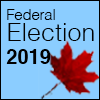 By Staff By Staff
November 9th, 2019
BURLINGTON, ON
During the past two week our political columnist Ray Rivers has written about the way we elect our federal politicians.
The current system is called First Past The Post (FPTP) It’s pretty simple, the political party that wins the most seats gets to form the government. If no one political party has 50% of the seats in the House of Commons they do get a chance to meet and see if they can create a majority with the support of a different political party.
You know when they don’t have the support from another political party when there is a confidence vote. These are votes that have to do with money bills – the budget being the biggest one.
When the government cannot get the confidence of the House – the government falls and under normal circumstances an election takes place.
The Governor General can ask another political party to see if they can form a government. In theory at least.
Dave Meslin, the author of Teardown: Rebuilding Democracy from the Ground Up believes that Canada has it all wrong – he believes there is a way to elect Members of Parliament that allows everyone to be fairly represented based on the number of seats won. He has put together an informative series of graphics.
Here’s how Canadians actually voted at the ballot box:
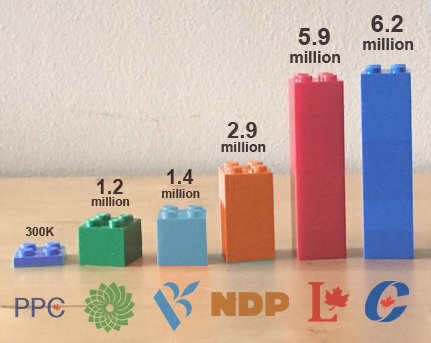 And here’s how that same chart looks, if we add all the registered voters who decided to NOT participate at all. And here’s how that same chart looks, if we add all the registered voters who decided to NOT participate at all.
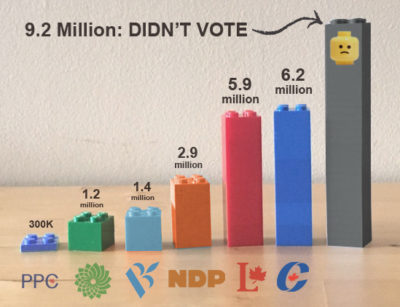 One third of all registered voters decided not to vote. Canada’s ridiculous voting system gives us a lot of reasons to not participate: One third of all registered voters decided not to vote. Canada’s ridiculous voting system gives us a lot of reasons to not participate:
Dozens of “safe seats” that never change.
Hundreds of candidates who “win” with less than 50% of the vote.
Endless chatter about “strategic voting” and “vote splitting”
Fake majority governments, that don’t actually represent a majority of voters.
Hostile and polarized election campaigns.
Larger parties getting more seats than they actually earned.
Smaller parties getting less seats than they actually earned.
Here are the seats “won” by each major party in Canada, on October 21:
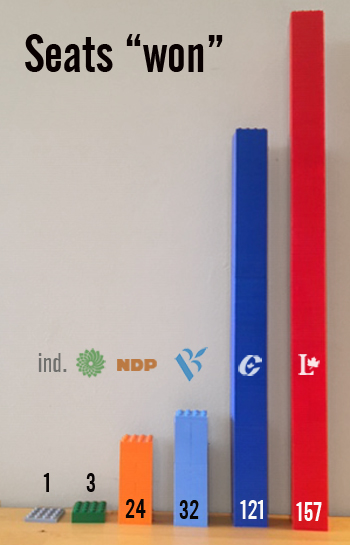 If you compare that to the ACTUAL vote we saw at the top of the page, you’ll notice a few major differences. First, the conservatives got more votes than the Liberals… but less seats. If you compare that to the ACTUAL vote we saw at the top of the page, you’ll notice a few major differences. First, the conservatives got more votes than the Liberals… but less seats.
That’s backwards.
Same goes for the Bloc Quebecois and the New Democratic Party.
The NDP got WAY more votes than the Bloc… but far less seats. Again, totally backwards.
And the Green Party, who earned almost as many votes as the Bloc, only won three seats – compared to the Bloc’s 32.
Lastly, the People’s Party didn’t win a single seat, despite having the support of hundreds of thousands of Canadians.
Proportionally, this is what Canada’s parliament should look like:
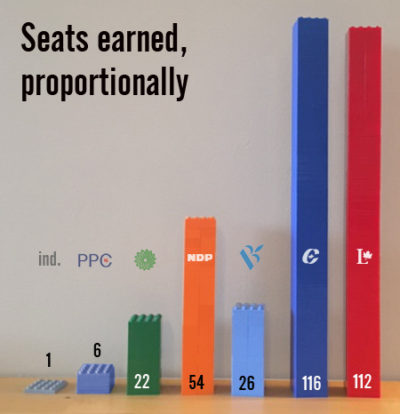 As you can see, the Conservative party would have the most seats – since they got the most votes! Of course, that doesn’t mean that they would be able to form a government. As you can see, the Conservative party would have the most seats – since they got the most votes! Of course, that doesn’t mean that they would be able to form a government.
In Canada’s parliamentary system, a party needs to gain “confidence of the House”, meaning that they either need to win a majority of the seats or find another party to support them in the House of Commons.
With 116 seats, the Conservatives are nowhere close to a majority:
In fact, the Conservatives would have a very difficult time forming a government based on the proportional results of this election. Even if the Bloc Quebecois AND the People’s Party supported them… it still wouldn’t be enough:
The most likely scenario would be some form of coalition or agreement between the Liberal party, NDP and Greens:
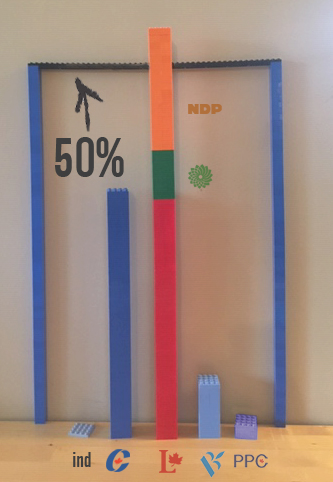 Under a proportional system, we’d also see an end to the wild distortions that paint Canada as a divided country with blue provinces and red provinces. While the seat count delivered on October 21st suggested that all Albertans voted conservative, all PEI voters are Liberals and the NDP has zero support in Quebec – the actual vote results reflect the diversity of opinions held across the country, in every province: Under a proportional system, we’d also see an end to the wild distortions that paint Canada as a divided country with blue provinces and red provinces. While the seat count delivered on October 21st suggested that all Albertans voted conservative, all PEI voters are Liberals and the NDP has zero support in Quebec – the actual vote results reflect the diversity of opinions held across the country, in every province:
What that means, in terms of seat count, is that some parties earn way more seats than they actually deserve, while First-Past-the-Post robs other parties of seats they should have won. Regionally, this is what creates the myth of single-party domination within a province:
Of course, all these numbers are based on the votes cast under our current system. If we had a modern voting system (like most Western democracies), everything would change – not just the math on election night. We’d have more parties. Candidates would campaign differently. We’d likely have different leaders. We’d all be able to vote with our heart. And we’d end up with stable coalition governments that actually represent what voters asked for.
Is that too much to ask for?
Rivers and Meslin appear to agree. But, when the province of Ontario thought about doing this they held a referendum and the public just didn’t buy into the idea.
When the Liberals won a majority of the seats in 2015, Justin Trudeau became Prime Minister. Part of his campaign was a promise to change the way Members of the House of Commons get elected. He created a Ministry of Democratic Institutions that was going to change the way citizens determined who would represent them.
The first Minister, Maryam Monsef wasn’t able to get the job done. The Prime Minister appointed Burlington’s Karina Gould the Minister of Democratic Institutions. She claims to have done her best – saying that she could not get the needed agreement from the other political parties – the attempt to change the way we elect Members to the House of Commons was abandoned.
The mess that came out of the 2019 election created a lot of dissatisfaction and ended up with the government not having a single member from Alberta or Saskatchewan.
The Liberals will need the support of either the New Democrats or the BLOC to pass any bills. The BLOC could care less as to how the Liberals pass legislation – they have said they will support the Liberals as long as any legislation they put forward meets the interests and needs of Quebec.
The New Democrats have a much stronger social platform and will have a strong interest in the way Members are elected to the House.
Interesting days ahead.
The Meslin graphics are certainly instructive; worth paying attention to.

 By Pepper Parr By Pepper Parr
November 7th, 2019
BURLINGTON, ON
Much of the public rationale for Marianne Meed Ward running in ward 2 in 2010 was that she would do everything possible to save the waterfront.
 Long time believers in saving the waterfront. Are there enough of them left to make a difference today? An organization was created – SOW – Save our Waterfront that Meed Ward rode all the way to city hall.
She was relentless with her use of social media. There were two film clips of her walking backwards along the lakeshore talking into a camera explain what she was trying to do with the waterfront and why. It was classic grass roots politics.
There are hundreds of people who still have their $10 SOW membership cards in their pockets. The organization morphed into the Meed Ward election campaign team.
In 2006 Meed Ward had run against Rick Craven in ward 1; the result of that election were not pretty. The Ward family moved from the Tyendaga community into the city core; ward 2 was a much easier win.
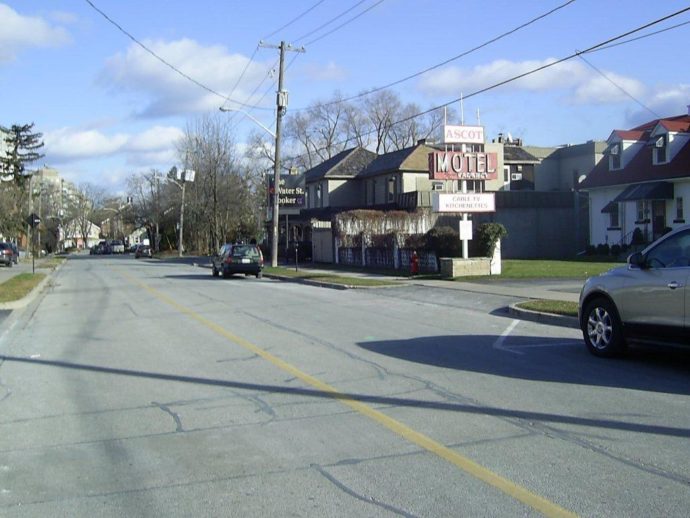 Everything on the right hand side of what is Old LAkeshore Road has to be left the way it is – no development on that land. The Motel is now in the hands of the people who own the Waterfront Hotel, Emmas is on land owned by Mayrose Tyco. This is where Mayor Meed Ward is going to have to find the leverage she needs. Does she have an ace up her sleeve? Marianne has made the waterfront her issue. She fought tooth and nail to save the waterfront land between Market and St. Paul Streets – to no avail. It was sold to a property owner who saw an opportunity to acquire lakefront property for a song. The full story behind how that came about is a little clearer now that Council got a chance to hear what leading real estate agent Michael O’Sullivan told the city when delegating on another matter.
She has watched the public presentations from the CORE people and Burlington Old Lakeshore Inc., part of the Carriage Gate interests. and realized she was up against some pretty big guns.
She should be able to hold her council with her on this fight, Bentevegna might be problematic. She is going to have to work very hard to ensure that the Planning department fully understands the “will of council.
 The four eight to 15 story structures is a lousy deal for everyone. But more than that – she is going to have to come up with a strategy. At this point it looks as if she is going to hang her hat on the zoning of 8 storeys as of right with up to 15 storeys if the right benefits are made available to the community.
She is going to have to deal with the tight grip the Conservation authority has on what can and what cannot be done south of the Old Lakeshore Road.
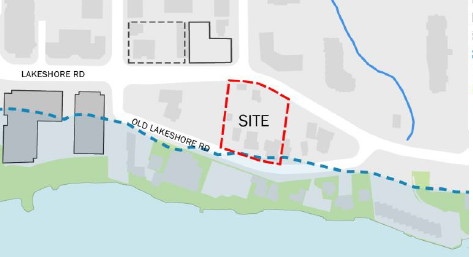 Conservation Halton has ruled that nothing can be built south of that dotted blue line. The buildings there now can stay, It is those buildings on the south side of Old LAkeshore that Meed Ward is going to have to find a way to leverage. What we didn’t see or even get a hint of from Meed Ward was that big, bold audacious idea that former Toronto Mayor David Crombie once told the Waterfront Advisory Committee was needed to save that piece of land.
Marianne understands the theatrics of politics. She use social media well, the ‘moth to a flame” part of her makeup will not serve her well. But these are small matters.
There is an opportunity to do something magnificent with the “football”. It will take imagination and a willingness to go for that “Hail Mary” pass, but if she can get her hands on the ball she will have created a legend for herself that can propel her some distance in the world of politics.
The 22 story Bridgewater development was done on Mayor Walter Mulkewich’s watch. It was originally going to be a 30 storey structure and be known as a legacy building.
Meed Ward can move the needle on legacy – but only if she surrounds herself with people that are imaginative, innovative and politically connected.
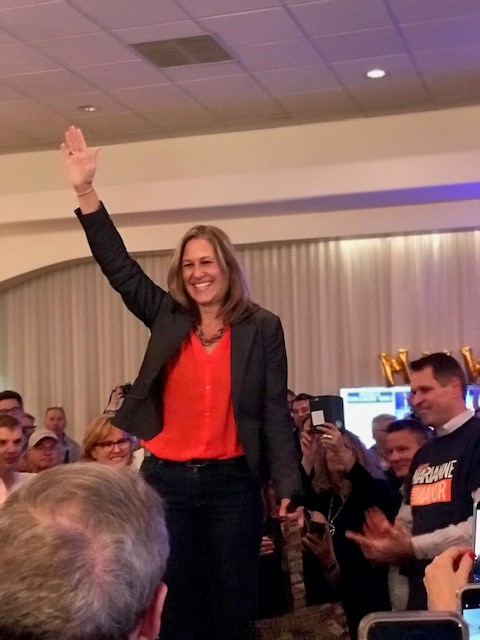 Victory is sweet – living up to the promise is the hard part. Settling for 15 storeys on that patch of land will be nothing to boast about.
There is time for a better brilliant idea to come forward – just not that much.
The Meed Ward position at this point is that there is policy in place that limits what can be done with the land. The developer’s consultant said these were guidelines with little in the way of force.
Meed Ward is going to have to galvanize the people in the Planning department to put the minds of some of the young and very bright people in the building to give the city their very best.
Meed Ward’s long term political career and the soul of the city that many people want depends on it.

 By Andrew Drummond By Andrew Drummond
November 6th, 2019
BURLINGTON, ON
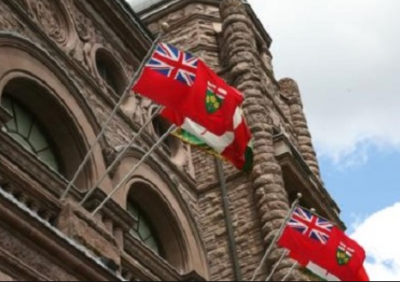 Has the Ford government learned how to govern? This past week, the Ontario government returned to the legislature after an extended five-month break. Upon their return, they prioritized Bill 124 that would cap yearly public wage increases to significantly below the rate of inflation (with exceptions for groups that typically support the Conservatives like Doctors and Police Officers). However, they also last week announced significant retreats to three previously announced policies. These retreats were unexpected, and well received, and it is worth digging into how impactful these retreats are and why the government did not maintain their initial policies. Then perhaps more importantly what this means for public action against future government policy.
In September, two senior members of the Ontario opposition shadow cabinet (Marit Stiles and Sandy Shaw) came to Burlington for a town hall on education issues. One of the things they said to the crowd in Burlington was that it was possible to fight the government on its changes. Marit offered the example of the Health and Phys-Ed curriculum as an example of where public pressure pushed the government into changing its mind about a policy supported by Conservative members. The government had made a big deal about holding back the curriculum introduced by the previous government, but after a year of protests essentially allowed that curriculum to move forward with only minor tweaks.
This week, one of their backtracks was on regional amalgamation. Last year, the Ford government made a number of aggressive unilateral overhauls to municipal governments. It cancelled the decisions of the Regions of Peel, York, Niagara, and Muskoka to have a Regional Chair position while infamously using legislation to change the ward boundaries in the City of Toronto in the middle of their municipal campaign. When in January Ford appointed an advisory committee on regional government many residents in Burlington and elsewhere were worried it would spark another round of unilateral changes, possibly including the amalgamation of Halton Region in some way.
 Public pressure worked. In response, residents across Ontario organized to oppose any forced amalgamation. In Burlington, the grassroots group “We Love Burlington – Stop Amalgamation” formed. Across Ontario similar groups formed that organized responses to the advisory committee and emailed their MPPs. In all over 8,500 submissions were received and the government announced this week that no amalgamations would be forced upon municipalities. The answer was that public pressure worked.
The second backtrack was regarding advertising for vaping products. Everyone in Ontario has seen the proliferation of vaping advertising in the past year. Last October, the Ford government passed Bill 36 which primarily dealt with regulations around cannabis products, but also included the enabling of vaping companies to actively promote their products in stores. It was a reversal of previous Liberal policy to ban such advertisements, and was criticized by many including the Canadian Cancer Society. It was a transparent capitulation to lobbying pressure with the government absurdly claiming that
“The government is focusing on protecting young people from the potential harms of e-cigarettes and secondhand vapour. Retailers can’t sell the products to minors and they can only be promoted if the promotion complies with federal law.”
In September, CBC ran a story that outlined a story that showed just how little the provincial government was acting to restrict teens’ access to vaping. Despite hundreds of reports to local health authorities, across Durham, Toronto, and Peel only 16 fines had been levied all year. Many stores that had public reputations for selling products directly to minors had never been targeted for enforcement. Local health, already struggling under cuts to their funding didn’t have the resources to apply enforcement. The result of all of this has been a 74% increase in teen vaping over the last 12 months. Nearly 15% of teens 15-19 regularly vape, which in Burlington means approximately 780 teens have likely been newly addicted to vaping since the government allowed the increased advertising.
Fortunately, the government has been able to see past its free market ideology and is starting to backtrack in order to protect teens from the dangers of vaping. The government announced this week that as of January 1, 2020 vaping products will only be legally advertised within establishments that restrict entrance to ages 19+.
The last government backtrack is actually not much of a backtrack at all.
Education Minister Lecce announced last week that government will only look to increase secondary school class sizes from 22 to 25 instead of the previously announced 28. This is a relatively transparent negotiating ploy for the government’s upcoming negotiations with both the elementary and secondary teacher federations. Unfortunately, for the government, few in the public accept that the 9% increase in class sizes is necessary and most are rightly concerned about the detrimental effect it will have on public education. Minister Lecce’s public comments that tax cuts can only be funded if education costs are cut did little to make anyone think that quality education was his top priority.
Making only half of their initially proposed cuts is not actually a solution. The beginning of the cuts came this year as secondary class sizes were raised from 22 to 22.5. This resulted in 124 teachers being cut from Halton region alone. The “walk back” from the government will result in “only” 600-700 more teachers being laid off over the next three years. While this is a backtrack from the over 1,000 that were going to be eliminated under the government’s initial plan, it will still have an incredibly damaging impact on school in our region.
But the point is that fighting the government has worked. Pressure on the education piece has made the government relent a little bit.
 Restrict teens’ access to vaping. Pressure on teenage vaping has gotten the government to do a flip-flop on their initial proposal. Pressure from local activists has made the government completely abandon its efforts to amalgamate local municipalities. The government has changed its priorities since the first year of its mandate, mainly in reaction to the plummeting polls. They are now considering walking back many other parts of their initial agenda.
The responsibility we have as residents is to keep the pressure on so that as little as possible gets cut to fund further tax cuts.
Andrew Drummond is Burlington resident who ran for the provincial seat in the last election. He works with a telecommunications firm in the private sector where hew applies his marketing skills.

 By Ray Rivers By Ray Rivers
November 6th, 2019
BURLINGTON, ON
Part Two – It’s Not a Horse Race
If not First-Past-the-Post (FPP) then what? Most parliamentary democracies around the world have evolved into some kind of proportional representation. We, in Canada, have not.
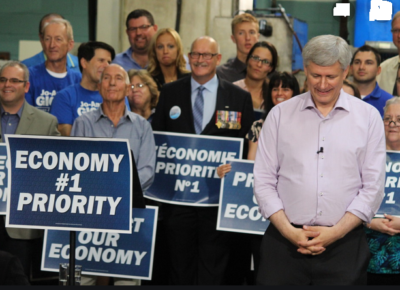 Proportional representation could be as simple as introducing a preferential or ranked ballot, as discussed last column. Also called a single transferable vote, it pretty much ensures that the political party elected as government had been supported by the majority of voters. In our last election the Conservatives had more popular support than the Liberals. But would they have gained more seats with a preferential ballot? Proportional representation could be as simple as introducing a preferential or ranked ballot, as discussed last column. Also called a single transferable vote, it pretty much ensures that the political party elected as government had been supported by the majority of voters. In our last election the Conservatives had more popular support than the Liberals. But would they have gained more seats with a preferential ballot?
There are more complicated and sophisticated forms of proportional representation and a link below provides an extensive discussion of these. New Zealand and Germany are good case examples. New Zealand, a fellow Commonwealth nation, has pioneered so much regarding democratic governance including becoming the first democracy to enfranchise women voters.
New Zealanders came to their version of proportional representation, called MMP for multi member proportional, via a series of public referendums. The first one in 1992 indicated almost 80% of the people wanted to change away from FPP. The next year a majority of voters chose MMP over the outdated FPP and a few years later it was in place.
Just to be sure people were satisfied with the change they had made, a follow-up referendum in 2011 confirmed they were on the right track and they would stick with MMP. New Zealanders get two votes at election time – one for the local candidate and one for the party they support. The party then appoints its best candidates based on the proportion of the vote they obtained. Being a 50-50% MMP there are an equal number of MPs elected by riding and appointed by the parties.
Coalitions among parties is pretty much the order of the day, though there is always the possibility of majority governments as well. Cooperation rather than conflict, though, is much more the modus operandi. That doesn’t mean parliament moves at snail pace as compromise might imply, but there should be fewer dramatic swings in policy, as we see in our system. Policies such as the long gun registry, the Northern Gateway pipeline and the non-partisan Senate would have had more consensus before implementation and more consensus before major changes.
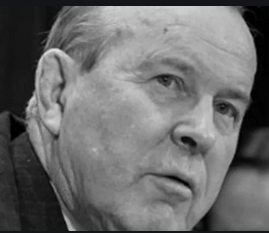 Lester B. Pearson was the 14th prime minister of Canada from 1963 to 1968, as the head of two back-to-back Liberal minority governments following elections in 1963 and 1965. For those who believe that Canada’s experience with minority government and quasi-coalitions or even rarer rare full-coalitions has been productive, MMP is the answer you’ve been waiting for. These folk would argue that our best governments have been during periods of minority, and will point to Lester Pearson as a shining example.
So what would have happened had Canada had a system of MMP instead FPP in the last election?
It’s all hypothetical, particularly since strategic voting had played such a big role in determining the final results. But assuming that voters hypothetically chose their MPs in the same manner as they did their parties, the results might look something like what we see in the table below, despite rounding errors.
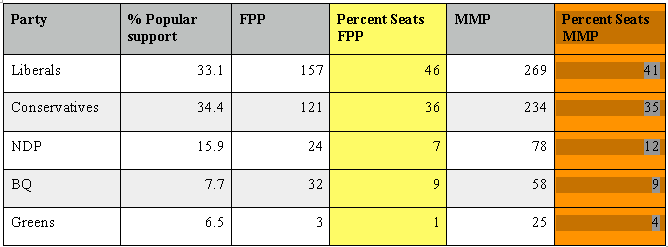 (note: includes rounding errors and excludes independent) (note: includes rounding errors and excludes independent)
In this hypothetical illustration based on the last election, the Liberals would still have earned the most seats though the Conservatives would have improved their position relative to them. The NDP would have moved from fourth to third place, better representing the percentage of the vote they got. And the Greens would have remained in last place though their strength in members would have increased to better represent their popular support.
The depiction above presumes the same number of electoral districts and that the House is expanded to accommodate a doubling of members (50% MMP). Note that while today the Liberals could govern with support from either of the NDP or BQ, under our hypothetical MMP they would need the BQ plus at least one of the other parties. The Conservatives, as before, would not be able to govern without the support of at least two of the third parties or with the support of the Liberals.
 Jason Kenney served in the Harper government – now he wants to form a government as Prime Minister. Mr. Trudeau is challenged to make his new minority government work with a nation more divided than we have seen in decades. While it is easy to understand Quebecers voting for a party dedicated to their interests and with a charismatic leader, what happened in the west is concerning. The Liberal shut out was deliberate and orchestrated somewhat by the Alberta premier and his Saskatchewan cohort.
Jason Kenney’s goal was to defeat Justin Trudeau and he very nearly succeeded. It was a dangerous manoeuvre for a provincial premier which exceeded anything this country has ever seen, and even over the top given the performances of former Quebec separatist leaders like Lucien Bouchard, Rene Levesque or even Jacques Parizeau.
Though the newly formed Wexit political entity, seems like an adolescent bad joke today, one should not underestimate the ability of this movement to damage the apple cart we call confederation. We could call them Canada’s tea party with their “Make Alberta Great Again” blue hats and upturned Canadian flags, but nobody should dismiss them as just a fringe movement or childish pack of whackos.
 Would this be if it was an international border ? Perhaps one day they’ll explain why it would be easier for a landlocked Alberta to build a pipeline across an international border than over a provincial boundary – and why with the highest provincial per capita incomes contributing to national equalization is so unfair. Still, without some kind of formal representation in Canada’s government, these separatist voices in the west will only become louder, angrier and nastier.
And that alone should give Mr. Trudeau cause to think about adopting some form of proportional government which would allow the Wexiters and the Greens, and even the Bloc, the scope to channel their energy in a productive way.
Part 1
 Ray Rivers writes regularly on both federal and provincial politics, applying his more than 25 years as a federal bureaucrat to his thinking. Rivers was once a candidate for provincial office in Burlington. He was the founder of the Burlington citizen committee on sustainability at a time when climate warming was a hotly debated subject. Ray has a post graduate degree in economics that he earned at the University of Ottawa. Tweet @rayzrivers Ray Rivers writes regularly on both federal and provincial politics, applying his more than 25 years as a federal bureaucrat to his thinking. Rivers was once a candidate for provincial office in Burlington. He was the founder of the Burlington citizen committee on sustainability at a time when climate warming was a hotly debated subject. Ray has a post graduate degree in economics that he earned at the University of Ottawa. Tweet @rayzrivers
Background links:
What Canada Can Learn – Proportional Representation – German Political System –
New Zealand System – More NZ System – WEXIT –

 By Gary Scobie By Gary Scobie
November 6th, 2019
BURLINGTON, ON
Once more into the breach. While there have been some good measures this new Council has brought about in 2019, on the most important issue you face, I am feeling frustrated and disappointed.
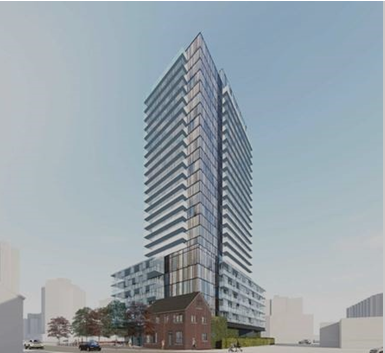 Keeping the historic Chrysler Carriage House and leveraging its heritage to get additional height for a development many think is taking place in the wrong part of town. I am delegating in opposition to the 27 storey mixed use condo application for 2093 etc. Old Lakeshore Road, in the middle of the
“football” between Old Lakeshore Road and Lakeshore Road. I would suggest nothing higher than mid-rise at this location and the
same goes for the site being planned next door to the east at the corner of Old Lakeshore and Lakeshore Roads. We don’t need
skyscrapers in our faces as we enter the eastern gateway to the downtown.
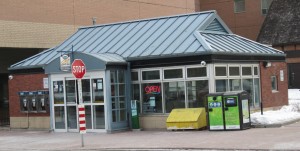 There was a time when a much larger bus terminal existed 25 yards to the left of this small terminal on John Street – it was where people met. Today this tiny structure has been defined as an Anchor Hub. I am frustrated that the Interim Control Bylaw (ICB) has only four more months to run and Council still has not acted on its mandate from citizens to rid us of the Anchor Mobility Hub (AMH) and Major Transit Station Area (MTSA) designations downtown. Nor has it moved the Urban Growth Centre (UGC) to the Burlington GO Station. These requests have been there since ECoB formed.
The three un-designations would free you from having to scramble to please the Local Planning Area Tribunal (LPAT) with your refusals to bend to developer demands to build high, build dense and build expensive on small sites in our downtown.
I am disappointed that instead Council is having the Planning Department spend time and expertise teasing out designs for downtown precincts (excluding Old Lakeshore precinct I might add) to please no one except developers.
This department should be using its expertise to support you in un-designating the downtown as an over-intensification project and reclaiming your right as a Council to decide on the intensification of our downtown that was already clearly expressed in the current Official Plan (OP). I attended the final Downtown Development Lab on Saturday and the crowd was not enthusiastic about either concept and was wondering why we were doing this exercise.
I last came here in June of 2019 and advised that your first priority to stop the further proliferation of high rise buildings near our
lakeshore like this one and in our downtown like others was to get us out of the cross-hairs of the development industry by making moves that Oakville Council in its wisdom did well over ten years ago. Instead we are still seeing applications such as this one that run counter to our vision of our lakeshore re-development and give developers an easy ride at the LPAT to gain height without maximums on small sites that only add to existing congestion and ultimately result in a rebuild of our downtown in their image.
Yet we are spending time updating an Adopted OP so it might pass muster under the over-intensification mandates you continue to allow to stand. You ignore the fact that our small Bus Terminal never qualified as an Anchor Mobility Hub because it has neither rapid transit nor dedicated transit to the Burlington GO Station Gateway Mobility Hub. You appear to ignore the ability you have to revise the boundaries of the Urban Growth Centre to direct high intensification like this building being applied for to the GO Station Mobility Hubs instead of in the downtown. Meanwhile the clock continues to tick toward the end of the ICB in March 2020.
The canyon effect along Lakeshore Road predicted ten years ago by Save Our Waterfront is about to come to pass unless strong measures are taken by Council.
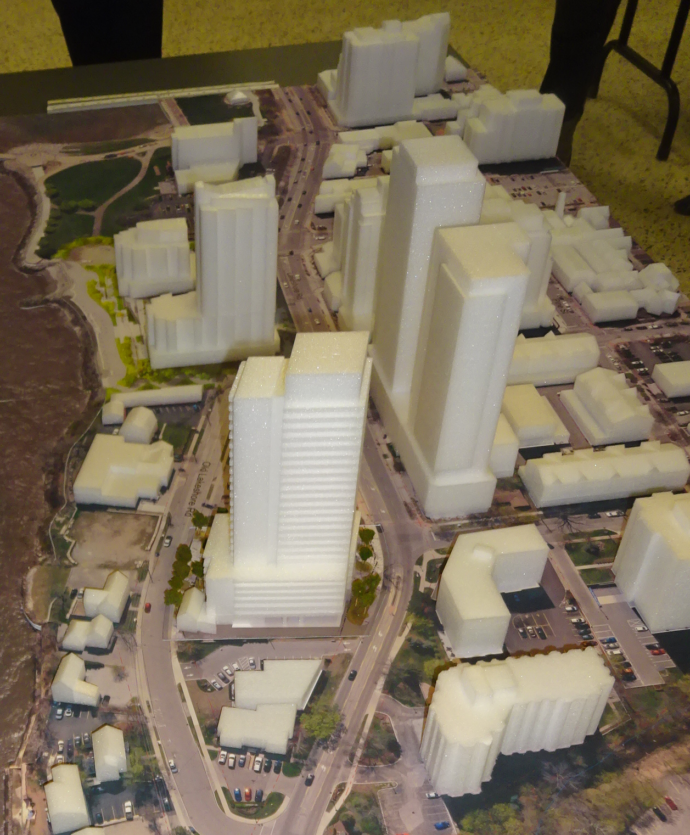 The canyon effect along Lakeshore Road predicted ten years ago by Save Our Waterfront is about to come to pass. At one time, I think citizens believed that we had enough historic buildings in our downtown to forestall high rise developments everywhere. Alas, we have very few buildings designated as historic and protected. If one happens to be on a site of properties assembled by a developer, like this one with the Chrysler Carriage House, it is incorporated in a tiny corner of the new building as simply a cost of doing business and a token to those who care about history. Old buildings or interesting facades like Kelly’s Bakeshop are incorporated in the build to lower our unease that our downtown is being stolen from us, to make us feel more comfortable with the redo that is unfolding. I believe that most citizens realize that these small measures are little compensation for what is being lost in total – the vision that Council promotes of a continuing attractiveness, walk-ability and vitality of the small town feel of Burlington’s downtown.
Developers have been assembling properties for years in anticipation of the goldmine that awaited them in high rise luxury condos, with token retail and office space that is mostly unaffordable for the very people we want to stay in the downtown.
Developers want to demolish and build new. You only have to look out your window at City Hall to see the blank slate that was 421 Brant Street. That is the dream of every developer. No trees, no buildings left, just a vacant lot ready to dig down deep for dungeon parking and building footings, set to rise to new heights each time. Wind or shadow issues? We’ve got experts who will tell you all is fine. No trees that will ever live past seven years because the beds are too small and too shallow? You can plant another one in its place. It’s all going to be wonderful with well-off people moving downtown to support the businesses that might or might not be left. What’s not to like?
This type of viewpoint might work at a true mobility hub where you can actually build from scratch a complete community for rail commuters, but it just doesn’t cut it in a downtown that actually does have some buildings, both high and low, that will stay for a long time and need to be built around in a respectful manner.
Members of Council, expect to see the developer of this application at the LPAT soon. In the meantime, please get working with Metrolinx and the Province to at least give you and your citizens a chance at saving our downtown, not frozen in time, but with a reasonable intensification target of our own making.
 Gary Scobie is a Burlington resident who has in the past delegated to city council. His research has informed public opinion. Gary Scobie is a Burlington resident who has in the past delegated to city council. His research has informed public opinion.
Related news and opinion content:
Is there anything that can be done to preserve the football?
Can the Mayor keep the dream alive?

 By Pepper Parr By Pepper Parr
November 5th, 2019
BURLINGTON, ON
Some thoughts and observations on the Committee of the Whole meeting that took place on Monday.
The number of city hall employees who quit increased by more than 80% during January to October 31st, 2019 when measured against the 2018 numbers for the same period.
 Councillor Sharman explaining his Father. Councillor Sharman told the world that his 98 year old father still drives a car, has a new girlfriend and is moving into a condo.
The difference in salary for people holding senior jobs who have decided to work somewhere else was reported to be as high as $15k to $20k
Retirements are up 67% over last year.
Council went into a closed session to discuss an Appendix to a report from Human Resources Director Laura Boyd who has told the city that there are some serious problems with the city’s pay rate.
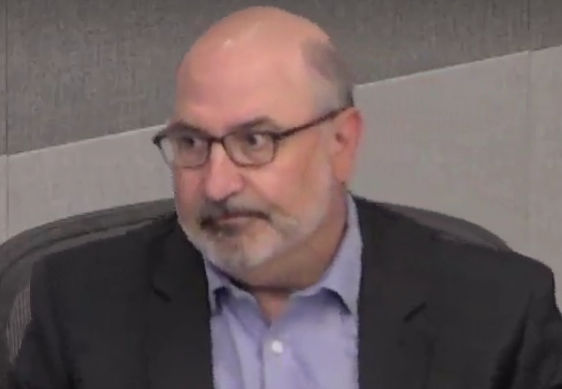 City manager Tim Commisso spoke about the The Evolution of the Customer Experience. They also went into Closed Session to discuss The Evolution of the Customer Experience. The report came from the hands of the City Manager who delivered it to Council late in the evening. That customer being you.
Mayor Meed Ward made it clear that she wanted to see more action and less waiting for reports from outside consultants.
Centurions are going to get a lot more attention in the months and years ahead. There are plans in the works to pay much more attention to those who have lived for 100 years. The city has literally dozens of them.
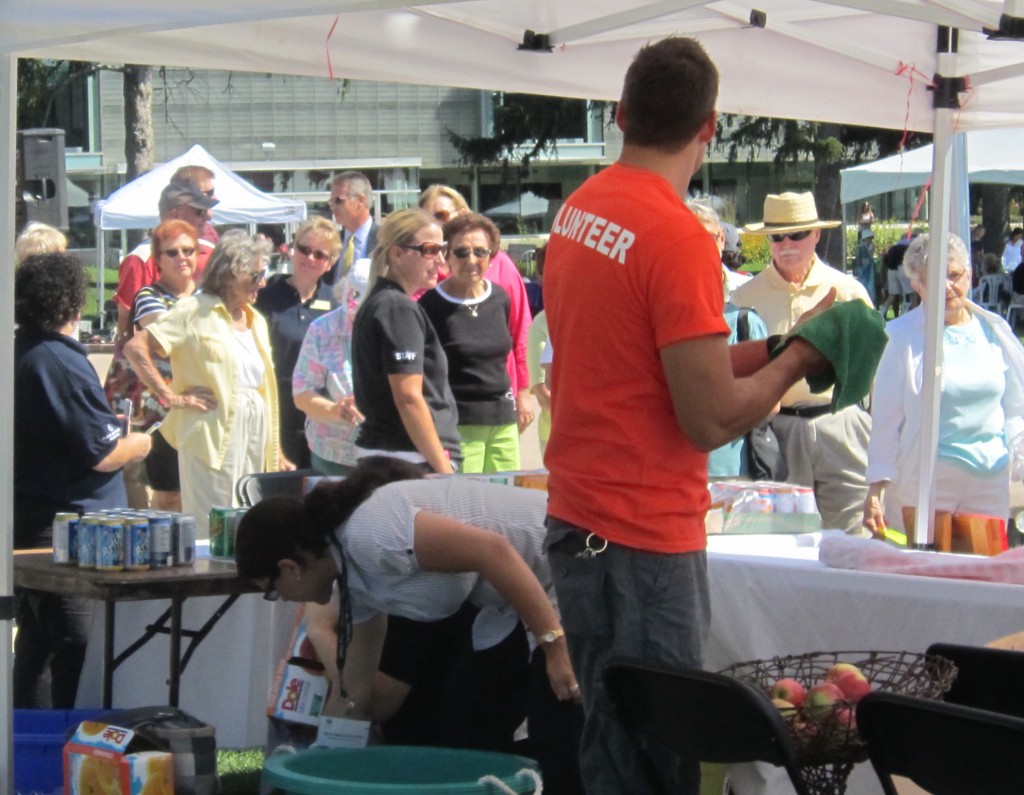 Lining up for a Brown Bag lunch – annual Seniors’ Centre event held at Central Park this year. The Seniors’ Centre is said to be busting at the seams – but there are no plans to build another one elsewhere in the city. Councillor Stolte didn’t see it that way and let the meeting know that she thought it was time to look for a location north of the QEW.
Councillor Sharman let it be known that he thinks Freeman Station should be operated by the Museums group.
There is a longish list of projects the city has been asked to take on – but they aren’t funded. Shortfall is $720,000 in 2020 alone.
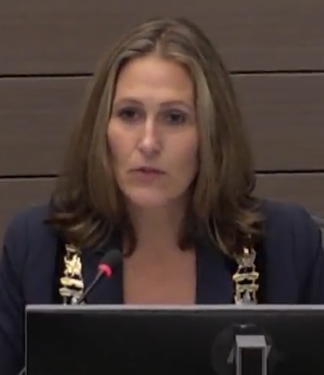 Mayor wants the city to be “nimble, agile and to move quickly Mayor Meed Ward told her colleagues that she is a little jaded on “plans”. She said she thinks she has seen four or five on transit alone.
She added that “we know we are going to plant thousands of trees – why do we need to wait until a plan is written?”
She wants city staff to be “nimble, agile and to move quickly”
Salt with Pepper is the musings, reflections and opinions of the publisher of the Burlington Gazette, an online newspaper that was formed in 2010 and is a member of the National Newsmedia Council.

 By Lawson Hunter By Lawson Hunter
November 5th, 2019
BURLINGTON, ON
The deafening silence that followed my delegation to Council of the Whole on Nov. 4th spoke volumes. I was there to urge Council to back up their claim of a ‘Climate Emergency’ as they pondered the Proposed 2020 Budget.
 The agenda item, “2018-2022 Burlington’s Plan Vision to Focus Financial Plan” was no doubt expected to be ‘received and filed’. However, as this would be Council’s (and the public’s) first glance at the new Budget – I jumped right on it and registered to delegate. I don’t think anyone expected that to happen. After all, a fuller report goes to Council November 18 after three closed Council Workshops to discuss in detail what is being proposed. Staff would like all this Budget stuff wrapped up by year’s end. Note: the 2019 Budget wasn’t finalized until March 26th of this year. The agenda item, “2018-2022 Burlington’s Plan Vision to Focus Financial Plan” was no doubt expected to be ‘received and filed’. However, as this would be Council’s (and the public’s) first glance at the new Budget – I jumped right on it and registered to delegate. I don’t think anyone expected that to happen. After all, a fuller report goes to Council November 18 after three closed Council Workshops to discuss in detail what is being proposed. Staff would like all this Budget stuff wrapped up by year’s end. Note: the 2019 Budget wasn’t finalized until March 26th of this year.
I visited the City’s GetInvolvedBurlington.ca website to gather some background and see what had been proposed. I clicked on Budget 2020 and there revealed was my first dilemma – the budget listed was for 2019.
Nevertheless, I had the 2019-2028 Approved Capital Budget and the latest version of ‘Vision to Focus’ (V2F) the guiding document that grew out of Burlington’s 25-Year Strategic Plan. Ambitious goals but no Operational budget numbers.
After an admittedly lame attempt at humour, I painted a nightmare scenario where the City took no action to address Climate Change (I called it a Climate Crisis). I asked, “What would people think of Council’s inaction 20, 30, 40 years from now?”.
In the Staff Report it stated:
It is important to note the V2F work plan is not being implemented in a vacuum, but rather aligned with organizational objectives and work plans and being cascaded down and linked into service plans.
If this is true, how is it that Council is being asked to approve a Budget without a Mobility Hub Plan; an Integrated Mobility Plan; a Climate Action Plan; an Urban Forestry Management Plan; a Green Fleet Plan; not to mention an official Official Plan?
The budget process provides a venue in which decisions are made to ensure the appropriate balance between affordability, service levels and financial sustainability are maintained.
There’s no balance to be had. We must act on all fronts and start the process today. Enough with studies. There are plenty of examples as to what other cities are doing to fight climate change. In fact, I gave various Council members a list of 103 actionable items that others cities in Canada have already put in place. Grab those concepts with both hands and start putting them into this Budget, I pleaded.
On the day before my delegation I stumbled upon the Proposed Budget 2020, all 686 pages of it. (www.burlington.ca/budget)
Approve the 2020 Operating Budget including any budget amendments approved by the Committee of the Whole -Budget to be applied against the proposed net tax levy amount of $173,597,452;
Capital Budget for the City of Burlington, with a gross amount of $85,791,551
Property taxes represent 65.5% of income for the City. The rest of the $264.9 million the City expends come from various revenues sources (think recreation fees, fines & debentures). However, the Budget default is already set at a 4% increase. Why look for any extras?
One thing that popped out at me was:
Business cases to address climate change impacts of $921K result in an additional tax increase of 0.55%
So what are we saying here? If you want to do something about climate change it’s going to go over-budget?
And:
Additional Items for consideration (not included in the proposed budget)
I think says a lot when you dangle nice concepts such as ‘Free transit for children under the age of 12”, and ‘Additional Forestry staff to implement a City-wide Tree By-law’ out on a limb, easy to chop off so you can say, “At least we kept the Budget increase at 4%”.
I also turned to the proposed Capital Budget to get a flavour of how the City viewed long-term actions. Even though it’s a bit of ‘apples to oranges’ the ‘Vision to Focus’ listed one of its 5 Focus Areas, “Supporting Sustainable Infrastructure and a Resilient Environment” the Budget lists many of the same items as “A Healthy and Greener City”. Say it quickly – it sounds very ‘environmental’. But including Cemeteries, Parks & Rec, and Organized Sport Support are a bit of a stretch for me.
When looking at the Capital Budget, I focused on things that could possibly relate to Climate Change: Tree Management – OK, Environment and Energy – yep, Storage Water Drainage – well, maybe. And where was Transit? That came under ‘A City that Moves’ along with Parking, Roads and Transportation.
So I tallied up the 324 Infrastructure spending items in the ‘Adopted Capital Budget 2019-2028’ and organized them as: Transportation, Roads, Bridges & Streetlights = 56.5% (of budget); Parks, Community Centres, Splashpads = 29%; Erosion, Culverts, Cycling & Trails = 10%; and finally, Transit = 4.5%.
I’ll leave it up to you what you consider Climate Change adaptation, and how much emphasis the City places on my motivating concern.
 Lawson Hunter wanted maps which he finds don’t exist. This is the best the Gazette has. With a minute to spare, I concluded by noting some of the shoreline clean-ups that I, and many others have done. I mentioned the Repair Café (next one on Nov. 16), my weekly environmental podcast, and the fact that I took the bus to City Hall. I’ve asked the City for floodplain maps and ‘buried creek’ and culvert maps – apparently, they don’t exist! This was not to put myself on a pedestal but to merely observe that I, and others in Burlington, are doing their best to combat Climate Change, often without much in the way of thanks.
Now it was time for City Council to do their part come Budget 2020.

 By Ray Rivers By Ray Rivers
October 31st, 2019
BURLINGTON, ON
Part 1 of a 2 part column.
There is no better way to determine the winner in horse races or athletic track events than first-past-the-post (FPP). It is crude and simple but very effective. However an election is not a horse race.
And as for gambling, there is a kind of gaming we employ in our politics – something we call strategic voting. In this last federal election over a third of voters claimed that they had voted strategically, switching their vote from their preferred party to another one. Almost 40% of those switches went to the Conservatives, likely in the west, where the Liberals were deliberately shut out from Winnipeg to Vancouver. And almost half of those who ultimately voted Liberal did so even though the NDP was their first preference.
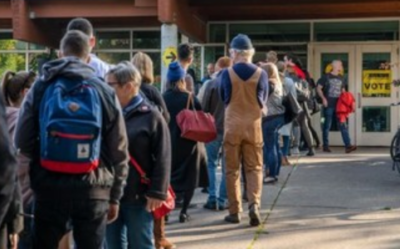 Canadians lining up to vote – do they have a chance of getting the representation they deserve? Clearly something is wrong with our system. If not broken, it could at least be made better because politics should be a serious business, not a crap shoot. And like a crap shoot so many voters are playing the game blind – looking at the polls and making strategic decisions they can only guess will work out for them. A lottery might be a better metaphor.
I’d like to vote for the party whose platform, and perhaps even leader, most appeals to me – doesn’t everyone? Instead we play this game of second guessing the outcome. We vote for a party we may not really want, just to make sure that the one we really don’t want doesn’t get in. Crazy huh? A casualty resulting from relying on a very imperfect and outdated voting system which was never intended for a multi-party democracy.
In fact what voters are doing is playing the odds. It is a kind of intuitive preferential voting in a FPP system. But a real preferential or ranked ballot allows electors to prioritize their selection of candidates, and thus parties. If no candidate gets at least 50% of the vote then second and third choices are counted until somebody gets at least half the voters. That winner is a first, second or third choice of the majority of the voters.
Preferential balloting is a variation on the theme of FPP, since everything but the ballots and counting remain the same. The political parties use preferential balloting in their leadership contests and municipalities are jumping in with at least one foot. It better reflects the public’s wishes and is more democratic. So why not move this approach to, arguably, the most important political contest of all – federal elections?
Mr. Trudeau understands this, or at least did when he was campaigning and promising, in 2015, to get rid of our archaic FPP system. Why he just didn’t implement this system following his 2015 election win is a good question. He decided to follow parliamentary procedures and create a committee. But the committee was dominated by the opposition and they outwitted him, recommending proportional representation, but demanding a national referendum. And ranked ballots never got past the idea stage.
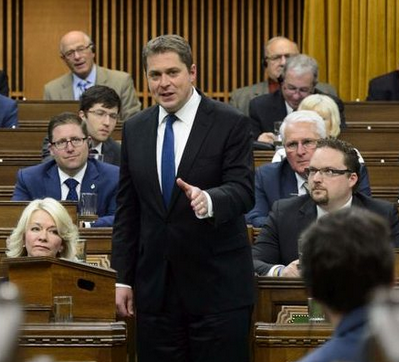 Doomed to perpetual opposition under a preferential voting system. The Conservatives likely have a larger and more loyal base than the Liberals and they certainly raise far more money. Half of those voting Tory had made up their minds before the campaign had even started compared with less than a third for the Liberals. But over 60% of Canada’s electorate prefer liberal-type to conservative policies. So the Conservatives, having become even more anti-progressive in the last couple of decades, would be doomed to perpetual opposition under a preferential voting system.
Yet, as we see, the Tories can and do win under the unranked FPP. For example Mr. Ford won Ontario’s last election with a majority of seats and only 40% of the total vote. And yes many of the party’s candidates failed to get 50% of the vote but slipped up the middle. It is little wonder some voters cannot be bothered voting, the odds are stacked against them unless they are fans of either of the two main parties.
And then there is the hope of political reconciliation. Since a preferential ballot more accurately represents the wishes of the majority of the voters, the main parties on the right and the left would be forced to move more to where the bulk of the voters are if they want to win. Political reality rather than abject ideology should end up playing a greater role in policy. And the third and fringe parties could continue to offer ideas, even though they would face the prospect of fewer elected members themselves, and possibly an eventual demise.
 Had the Liberals decided to use a preferential ballot they might easily have landed a majority. It was a horse race you could they’d have won. That is the downside. That Canada under a preferential balloting system might devolve into a two party system. It would be nice to think that Trudeau was dissuaded from changing our balloting system for that reason – that he was primarily concerned about the consequences for the third parties. After all given the outcome of October’s election, a preferential ballot might easily have landed him a majority. A horse race you could bet he’d have won.
 Ray Rivers writes regularly on both federal and provincial politics, applying his more than 25 years as a federal bureaucrat to his thinking. Rivers was once a candidate for provincial office in Burlington. He was the founder of the Burlington citizen committee on sustainability at a time when climate warming was a hotly debated subject. Ray has a post graduate degree in economics that he earned at the University of Ottawa. Tweet @rayzrivers Ray Rivers writes regularly on both federal and provincial politics, applying his more than 25 years as a federal bureaucrat to his thinking. Rivers was once a candidate for provincial office in Burlington. He was the founder of the Burlington citizen committee on sustainability at a time when climate warming was a hotly debated subject. Ray has a post graduate degree in economics that he earned at the University of Ottawa. Tweet @rayzrivers
Background links:
Federal Election Results – Strategic Voting –

 By Pepper Parr By Pepper Parr
October 31st, 2019
BURLINGTON, ON
It is a nasty, sneaky, dishonest way of explaining to tax payers how much of a tax increase they are going to be hit with.
The tax bill people get includes taxes levied by the school boards, taxes levied by the Regional government and taxes levied by the city of Burlington.
It was found to be more efficient to put all the taxes on the one bill – it also made it easier to collect.
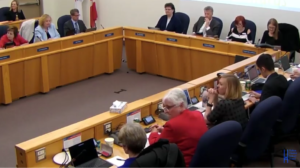 The Board of Education determines how much money they need in the way of taxes; all the city does is collect it for them. The city has zip influence on what the school board levy in the way of taxes to pay for the operation of our school system. All the city does is collect the money and pass it along to the school board.
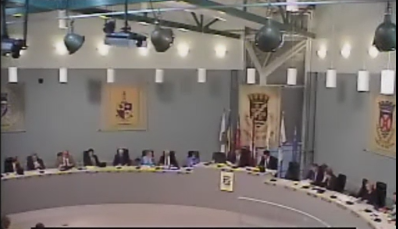 Burlington has seven votes on the 24 member Regional Council – input on the tax levy – nothing more than that. The city has some (not very much) influence on what the Region decides they need in the way of tax money to operate the services they provide: police, the water system, waste management along with health and social services.
The only tax level the city controls is what they spend on delivering the services they provide.
In the 2020-2021 budget that is to go before Council in November reference is made to “unfunded service enhancements which if added to the budget brings the city tax increase to 4.73% (2.76% when combined with the Region and Education taxes).
The public is looking at a tax increase of more than 4% – probably close to 5% once they decide just how much they want to spend on climate control matters.
What Council does when they play around with the numbers is akin to the 17 year old, single daughter who says to her Father: Daddy I am just a little bit pregnant.
Taxes are inevitable. Treat the public with the respect they deserve and tell them the truth. Stop the pussyfooting around.
 This city council has an opportunity to teach the bureaucrats to be more open and honest with the tax payers. 
 By Pepper Parr By Pepper Parr
October 29th, 2019
BURLINGTON, ON
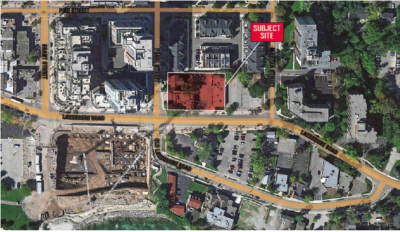 The land between Lakeshore Road and Old Lakeshore Road has been referred to as the football every since we started publishing. Why would the city want to name is the peanut? Is it a football or a peanut?
What most people know as the “football” was referred to as the peanut by Director of Planning Heather MacDonald at one of the Action Plan sessions last week.
 Is it a football ….  …or a peanut? It is probably the most significant piece of developable land left in the downtown core.
In time it might equal Spencer Smith Park in importance to the look, feel and public open space in the city.
Right now there are developers crawling all over the land with proposal for developments that will rise more than 25 storeys.
The Carriage Gate Group subsidiary Lakeshore Old Burlington gave a presentation to a very small group at a public meeting recently. No one has yet to explain why that meeting was so poorly promoted.
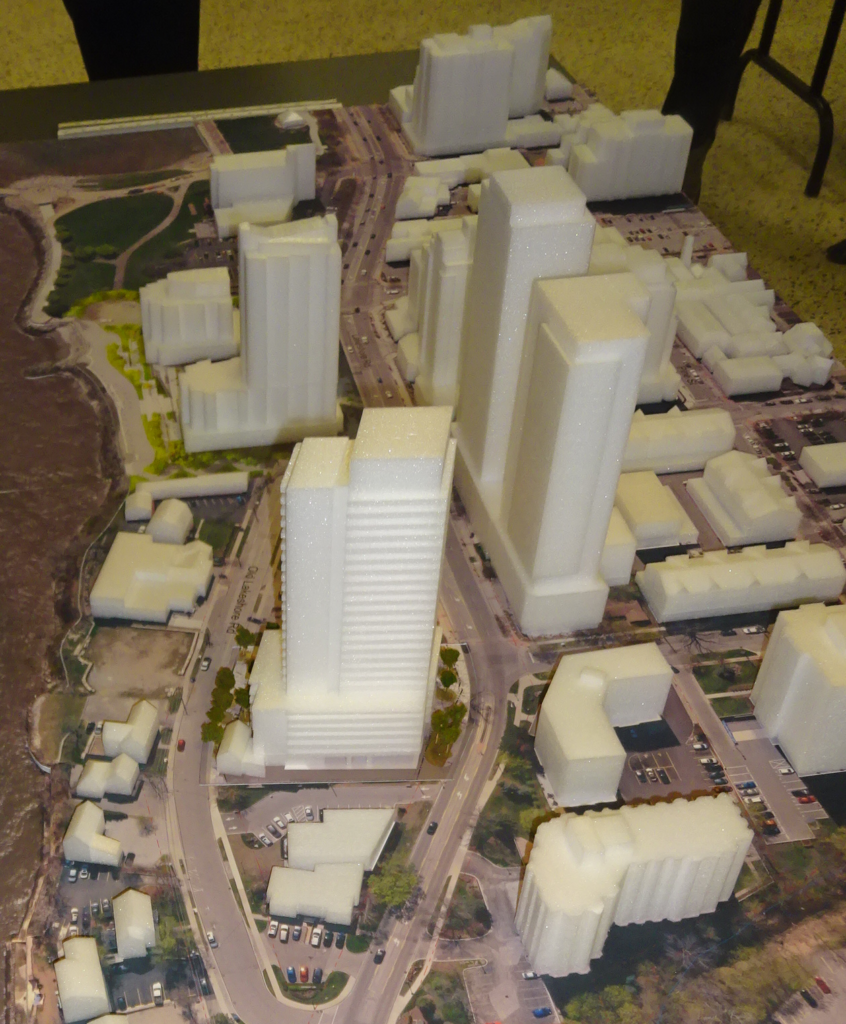 Not much of that quaint, walk-able community in this 3d model of what the CORE Development group want to dump into the ‘football’. The CORE Development group gave the public a good look at what they have in mind for the properties to the west of the Burlington Old LAkeshore proposal.
They will be making the required Statutory presentation to city council on November 5th at city hall
 Lakeshore Mixed use precinct – on the north and south side of Lakeshore from Locust to Martha. Each property will have its own rules put in place. During the two Action Plan workshops the city held for residents some people wanted to know why the “football” and the Lakeshore Precinct were not included in the public think sessions.
They were told by the Director of Planning, Heather MacDonald that those precincts were to be the subject of separate studies once the revisions to the adopted but not yet approved Official Plan are in place.
One can sympathize with the workload the Planning department faces but the “football” and what has been defined as the Lakeshore precinct are just as important as the look and feel of Brant Street if not more so.
What makes Burlington the city it is – is the lake.
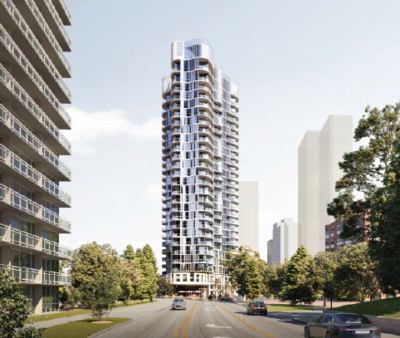 At the eastern edge of the football – the tower will become the gateway to the downtown core.  This structure is to the immediate west of the latest Carriage Gate Development.
The millions spent on the Pier; the millions spent on getting public access to the lake at the foot of the Bridgewater development and public access to the lake through that development will be for naught if there are no rules that apply to the football and the Lakeshore precinct.
At this point there are two mammoth development applications for the “football” on the table
Let us not repeat the terrible mistake with that Anchor Hub – the label that got stuck on a tiny bus terminal.
Related news stories:
The stunning development planned for the “football”
Can high rise development be brought to an end?

 By John Cole By John Cole
October 29th, 2019
BURLINGTON, ON
With MLB players expressing themselves like never before, author Jason Turbow explains how baseball can maintain its code of respect and fair play.
It’s Game 1 of the 2019 National League Divisional Series.
 Ronald Acuña Jr: He stands and watches as it sails towards the wall, and remains in the batter’s box as it drops into the 10th row of seats. He lets out a roar and begins his slow, celebratory trot around the bases. Ronald Acuña Jr. – playing in just the fifth playoff game of his career – launches a fly ball into left field. He stands and watches as it sails towards the wall, and remains in the batter’s box as it drops into the 10th row of seats.
He lets out a roar and begins his slow, celebratory trot around the bases.
Normal behaviour after hitting a home run, you might think, but baseball’s code has been broken.
Four games later, against the same opposition, Acuña Jr. steps up to the plate again. The Atlanta Braves need a hero. They trail 13-1 in Game 5, with their chances of reaching the next round all but extinguished.
Acuña will not, however, get a chance to be that hero. The pitch drills him on the arm. Revenge has been served.
Don’t celebrate a home run. Don’t bunt to break up a no-hitter. Don’t steal a base with a big lead late in the game. Don’t walk across the pitcher’s mound. These are just a few of baseball’s many unwritten rules.
If you break them, then expect consequences. More often than not, those consequences come in the form of a well-directed pitch, as Acuña Jr. now knows.
Such retaliation has been commonplace in the MLB for decades as players take it upon themselves to enforce their code, even when it’s their own teammate who is in the wrong.
 Jason Turbow, author of The Baseball Codes, recalls a story from 1996 involving Los Angeles Dodgers outfielder Roger Cedeño. The Venezuelan stole a base against the San Francisco Giants with an 11-2 lead late in the game, infuriating the opposition. Jason Turbow, author of The Baseball Codes, recalls a story from 1996 involving Los Angeles Dodgers outfielder Roger Cedeño. The Venezuelan stole a base against the San Francisco Giants with an 11-2 lead late in the game, infuriating the opposition.
His team-mate, Eric Karros, headed over to the Giants’ dugout and told them: “We’ll handle this.” When reporters were allowed into the Dodgers’ clubhouse after the victory, following the team debrief, Cedeño was wiping tears from his eyes.
Things are, however, starting to change.
Bat flips are becoming a common sight. Players are beginning to express themselves in ways the sport has never seen.
“The beautiful thing about the unwritten rules, for me, is that they are ever-evolving,” Turbow explains.
“The code that ball players abide by today is very different to how it was, even 10 years ago, which was in turn very different to a generation before that.
“People just aren’t as offended now as they used to be about these things.
“For example, it used to be you couldn’t dig in to the batter’s box – you co uldn’t shove your toe down into the dirt to get a good foothold – at the risk of offending pitchers back in the sixties and seventies. No one even notices that now.”
The move away from strict adherence to the code has been gradual, taking place over many years, and can primarily be explained by a change of mentality among modern baseball players.
Before free agency rules changed in the 1970s, movement between MLB teams was restricted, meaning many played for a single franchise for the bulk or entirety of their career.
This, Turbow explains, is why the unwritten rules were so strictly enforced.
“Up until the free agency era you were on a team, more or less, for life,” he says.
“Some players got traded, some players got released, but the only way you left a team was if they didn’t want you anymore. And thus, you built bonds with your teammates. You built antagonism with your opponents.
“In the modern era, players sometimes jump from team to team every couple of years. They go on vacations in the off-season with each other, they share agents, they do charity golf tournaments together.
“Every team is filled with players who have friends on every other team. The antagonism just isn’t there anymore.
“Whereas once you were offended by something a stranger, or an opponent who you already had antipathy toward, would do, now your opponent, who you like, is doing that same thing, you’re not even going to think about it.”
The increasing number of international MLB players – such as Acuña Jr. and Cedeño – has also contributed to this shift.
More than 25 per cent of players in the league now come from outside the USA, hailing from 20 different countries, all with their own way of playing the game.
“When it comes to integrating foreign players, there is going to be a transition process,” Turbow says.
“The brand of baseball they play in Latin America, for example, is very different.
“Celebrations are embraced down there. They are expected. This is the kind of baseball that those guys grew up learning, and now they’re bringing it to the United States.
“The Asian players, particularly the Japanese players, tend to play by even stricter rules than the Americans.
“Korean players flip the heck out of their bats. It’s all about getting used to each other.”
 Recently, however, the MLB has taken matters into its own hands. Advertising campaigns titled ‘Let The Kids Play’ and ‘We Play Loud,’ released ahead of the post-season in 2018 and 2019, explicitly condone behaviour that would previously have been condemned. Bat flips, showboating, celebrations. Anything goes. Recently, however, the MLB has taken matters into its own hands. Advertising campaigns titled ‘Let The Kids Play’ and ‘We Play Loud,’ released ahead of the post-season in 2018 and 2019, explicitly condone behaviour that would previously have been condemned. Bat flips, showboating, celebrations. Anything goes.
“This officially codified the idea that these kids can show emotion on the field – they can flip their bats, they can celebrate themselves in ways that fans find appealing,” explains Turbow.
“It is baseball’s way of trying to grow the fanbase, especially among a younger demographic.”
Baseball traditionalists are, however, not making it easy for MLB. They continue to cling onto the code, passing it down to younger generations.
Right now when a pitcher throws at a batter who has only just stepped in and not yet begun his 15 step routine (touch helmet, grind foot, cock elbow five times etc) it’s called a “quick pitch. That’s called unsportsmanlike like.
The game was designed by the best teams to move slowly. Anything done to change that pace unsettles everything. For a game that throws so much money into tactical analysis, baseball is terrible at tactical innovation
As a result, the sport is currently going through a transition period where the old and the new coexist uneasily, particularly with regards to celebrating.
“In previous generations, bat flipping was a no-no. Pitchers would get viscerally offended, sometimes to the point of throwing a baseball at an opponent in retaliation.
“We’re now in this weird grey area in that there are still some pitchers who feel that way. Never mind that baseball has officially decreed it appropriate to flip a bat, there are still some pitchers who get annoyed at it.
“That creates some cognitive dissonance when it comes to how players behave on the field. They’re still trying to work it out.”
How, then, does baseball move forward? Can these unwritten rules, formed over a century or more, coexist with modern, fast-paced baseball?
“I think so,” asserts Turbow.
“These unwritten rules are fluid – they evolve. The idea of showing respect on the field is compatible with players having outside personalities, Twitter accounts and whatnot.
In the meantime it is a great game to wager on.
“It’s only when it comes to celebration that the hardliners and the traditionalists have a problem, and the traditionalists are dying off on a daily basis.”
So perhaps, in five years’ time, Acuña Jr. will be able to stand, admire and celebrate without fear of retribution being hurled at his ribs at 90 miles per hour.
John Cole has been watching baseball for more than four decades. His Dad took him to his first game. He likes the pace of the game and all those unwritten rules – but knows that changes are in the making.

 By Pepper Parr By Pepper Parr
October 28th, 2019
BURLINGTON, ON
OPINION
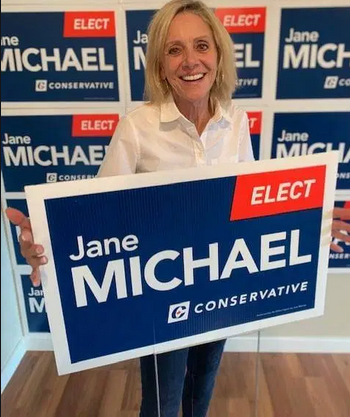
Update:
In the closing sentence of this article we said: “They wonder why Burlington could not find a decent Catholic candidate to represent them..
The they was the Catholic community. Several readers questioned the Catholic reference, informing us that the candidate didn’t have to be a Catholic and that is correct. What we were saying is that many in the Catholic community in Burlington wanted someone to represent their views in the House of Commons. The Conservative party leadership appeared to like the look of Jane Michael. Many Catholics in Burlington didn’t. And many who were not Catholic were terrified that Michael would get the traditional Conservative vote and take the seat. Sanity prevailed.
It is just a little after the votes were counted and the riding of Burlington re-elected Karina Gould that the Gazette was finally able to communicate with a second person who was able to confirm what we were given by a Burlington resident on the way Elizabeth Jane Michael was named as the Conservative Party candidate.
We wanted someone to corroborate what we had learned – but were not able to do so before the election.
Our source wrote the following. We have been able to confirm that the writer is real but for personal job related reasons we cannot reveal the names of either source.
“I could easily add to all the ‘unusable’ dirt I hear you have been receiving about Jane Michael, but I’m not going to do that now.
“The line you have about Burlington conservatives not being able to understand how Jane Michael became the Conservative candidate is certainly true. The information I have will shed some light on this and explain why CPC chose Jane Michael to be Burlington’s candidate. This is just me putting the threads together. Jane Michael’s Campaign Manager is Paul Marai. Their history goes way back. They served eight years together as trustees on the HCDSB. Marai also has a big connection to the Conservatives.
“Here are a few of bits of info:
Elizabeth Jane Michael was sanctioned by the HCDSB in May of 2018 for ‘violating code of conduct’ at an in-camera meeting.
“In a news report in another publication HDCSB Anthony Quinn said: “The reprimand may not seem like much, but it’s the strongest sanction available to the board under the legislation.”
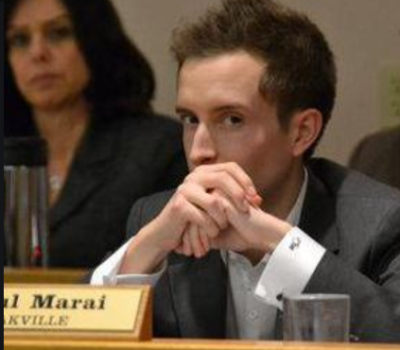 Paul Marai was Michael’s Campaign Manager. He is also the Director of Digital operations for RMG – The Responsive Marketing Group Inc “At the board’s public meeting May 15, 2018, vice-chair Paul Marai read a motion announcing the sanction and stating the penalty: Michael is barred from attending two board meetings, removed from her position on the discipline committee and excluded from the search for a new director of education “from the beginning to the end of the hiring process.”
“Michael had the highest trustee expenses while with HCDSB. Many other controversies.
“Michael’s Campaign Manager, was Paul Marai who is a Digital Director of RMG – The Responsive Marketing Group Inc. This company does work for political parties, and election work from federal to municipal. One service they provide is robo calling.
“In RMG marketing material RMG is described as an industry leader for over 20 years. “Responsive Marketing Group is Canada’s preeminent integrated political marketing services company. We bring together decades of experience in voter contact, fundraising, and cutting edge data science to offer unparalleled audience insight and engagement services.”
“RMG does work for the Conservative Party of Canada and has done work in the Burlington and neighbouring ridings for years provincially and federally. Paul Marai, through the company RMG, has a connection to Andrew Scheer’s campaign team and Conservative party staff.
“Marai was helping Jane when she tried to win the PC nomination in 2016.
“This ‘Michael to Marai to Scheer/Hamish Marshall connection’ is why Burlington conservatives ended up with Jane Michael.” Hamish Marshall was Andrew Scheer’s campaign manager.”
Our source adds that “there is certainly nothing wrong with all these connections.” She felt the public had a right to know.
Our first source gave us basically the same information.
The Conservative Party liked the strong Catholic anti abortion position Michael had taken and were prepared to go to some lengths to get her there.
But there was just too much that didn’t smell right and the voters of Burlington decided to stay with the incumbent. Many strong Conservative Catholic voters in Burlington spoke to the Gazette saying that they couldn’t stomach the candidate they were told they had to take.
They wonder why Burlington could not find a decent Catholic candidate to represent them.
They are out there.
Related news stories:
Gazette hacked.
Pepper Parr is the publisher of the Burlington Gazette, an online newspaper that was formed in 2010 and is a member of the National Newsmedia Council.

|
|
 By Lynn Crosby and Blair Smith
By Lynn Crosby and Blair Smith




































































































